BELMORE AND LAKEMBA LOCAL CENTRES



The City of Canterbury Bankstown acknowledges the traditional custodians of the land, water and skies of CanterburyBankstown, the Darug (Darag, Dharug, Daruk, Dharuk) People. We recognise and respect Darug cultural heritage, beliefs and relationship with the land. We acknowledge the First Peoples' continuing importance to our CBCity community.

If we care for Country it will care for us

In 2022, Architectus was engaged by City of Canterbury Bankstown Council (CBC) to prepare a master plan for the Belmore and Lakemba Local Centres, to help plan for the growth of the centres into the future. Both centres are located along the new Sydney Metro City to Southwest corridor, a significant public transport project by the NSW Government, that may instigate development opportunities around the new Metro stations.
In late 2023, the NSW Government announced the Transport Oriented Development (TOD) as the key strategy to increase housing in well-located areas focused around selected transport hubs. In April 2024, Belmore and Lakemba were announced as Tier 2 centres that would fall under the new TOD State Environmental Planning Policy (SEPP), which is due to take effect in December 2024.
Local councils are able to review and propose revised controls for their precincts so long as they can meet or exceed the expected number of dwellings under the TOD SEPP.
Purpose of this report
This report, 'Belmore and Lakemba Local Centres - An Alternative Approach to TOD' (the report), describes the draft strategy to address the TOD program, including aspects where an alternative approach to the TOD based on place-specific and tested design investigations, may result in enhanced outcomes.
This report, alongside the Proposed Planning Provisions report, has been placed on public exhibition to gain community and stakeholder feedback, after which a Development Control Plan (DCP) will be further developed.
An alternative approach to the TOD may address the overarching objective of the TOD program - to deliver increased housing around key transport nodes - while achieving an outcome that is place-specific and considers the unique characteristics and needs of Belmore and Lakemba. An alternative approach to TOD can achieve the following:
Place-based approach to renewal within Belmore and Lakemba
'Realistic' approach that takes into consideration existing constraints
Plans for future growth within the centres holistically, instead of focusing uplift within 800m
Allows for variations in height and density that is context-responsive
Ability to align community infrastructure and public domain enhancements with increased housing
Able to deliver more housing across the centre than the TOD program
Vibrant high streets that support street life and cultural expression
Existing
18
12
8
6
Existing
1-2
1-2
Existing

Architectus has been engaged by the City of Canterbury Bankstown Council (CBC) to prepare a master plan for Belmore and Lakemba Local Centres, to help guide the planning and growth of the centres into the future.
The investigation into the Belmore and Lakemba Local Centres began in 2022 to respond to the renewal opportunity instigated by the Sydney Metro project, a significant investment into public transport infrastructure by the NSW Government to improve connectivity across the network.
Future renewal along the Canterbury to Bankstown Metro Corridor was supported by CBC's Local Strategic Planning Statement Connective City 2036 (LSPS) and Local Housing Strategy (2020), which set out a centres approach to growth based on focusing future housing within existing centres supported by enhanced public transport access, as well as jobs and social infrastructure.
In late 2023, the NSW Government announced the Transport Oriented Development (TOD) program as the key strategy in the NSW Department of Planning, Housing and Infrastructure's (DPHI) vision to increase housing opportunities in well-located areas focused around transport hubs.
In April 2024, both Belmore and Lakemba were announced as Tier 2 centres that would fall under DPHI's new swathe of planning controls, enacted through a new TOD State Environmental Planning Policy (SEPP). For Belmore and Lakemba, the new TOD SEPP are due to take effect in December 2024.
The development of the Belmore and Lakemba Master Plan provides the opportunity for CBC to interrogate the proposed controls under the TOD SEPP and take a strategic and place-based approach to planning for these centres. This approach ensures that any new controls that increase height, density and capacity for housing are carefully considered, reflective of the local context and community, and supported by jobs, services, transport infrastructure, amenity and public domain improvements.
This report, 'Belmore and Lakemba Local Centres - An Alternative Approach to TOD' (the report), describes the draft strategy to address the TOD program. It includes aspects where an alternative approach to the TOD based on place-specific and tested design investigations, may result in enhanced outcomes.
The report describes a draft alternative approach through design principles, a structure plan and built form strategy for the Belmore and Lakemba Local Centres. This approach is supported by the Recommended Planning Provisions report (RPP), which outlines recommended amendments to key planning controls, and will be placed on public exhibition.
The approach will be further developed following the engagement period to incorporate the community's feedback and develop a robust place-based framework for change.
October 2022
April 2024
Place analysis study and visioning for the Belmore Lakemba Local Centres
City of Canterbury Bankstown Council (with Architectus and consultant team)
Belmore and Lakemba announced as Tier 2 precincts as part of the Transport Oriented Development (TOD) program (NSW Government)
Mid 2024
Development of a draft Alternative Approach and proposed planning controls
City of Canterbury Bankstown Council (with Architectus and consultant team)
October 2024
November 2024
We are here
Public exhibition of the 'An Alternative Approach to TOD' report and 'Recommended Planning Provisions' report
Revised draft Alternative Approach to TOD and Recommended Planning Provisions reported to Council City of Canterbury Bankstown Council (with Architectus and consultant team)
December 2024
Early 2025
Early-mid 2025
TOD finalisation for Belmore and Lakemba (NSW Government)
Preparation of amendments to Council's Development Control Plan and Local Infrastructure Contributions and more detailed public domain planning
City of Canterbury Bankstown Council (with Architectus and consultant team)
Public exhibition of draft DCP, Contributions Plan amendments and public domain planning
Mid 2025 Finalisation of draft DCP, Contributions Plan amendments and public domain planning
City of Canterbury Bankstown Council (with Architectus and consultant team)
The area within and around Belmore and Lakemba is Darug (sometimes spelt Dharug, Dharuk or Daruk) Country. The Belmore and Lakemba Local Centres are located within the Canterbury-Bankstown Council Local Government Area (LGA) and is approximately 13km and 15km southwest from the Sydney CBD, respectively.
Key elements of the Belmore and Lakemba Local Centres include:
The vibrant main streets, Haldon Street in Lakemba and Burwood Road in Belmore are centrally located, extending north-south over the railway line. The main streets provide everyday services and amenities, while also supporting community events such as Ramadan Nights in Lakemba.
· The area is culturally and demographically diverse with a strong sense of community. There are also important places of worship such as the Lakemba Mosque and the All Saints Orthodox Church, several schools, as well as other community infrastructure.
· A mix of housing types include detached houses, dual occpancies, terraces, multidwellings, walk-up apartments and mixed use development. The existing building heights generally range between 1-6 storeys, with a few recent developments up to 8 storeys.
· There are two key open spaces; Parry Park, and the 'Belmore Sports and Recreation Precinct' that consists of the Belmore Sports Ground and Terry Lamb Reserve. Scattered local and neighbourbood parks complete the open space network.
· The centre is bounded by Canterbury Road along the south. The busy Canterbury Road currently conists of a mixed character of employment uses, mixed use development and houses.
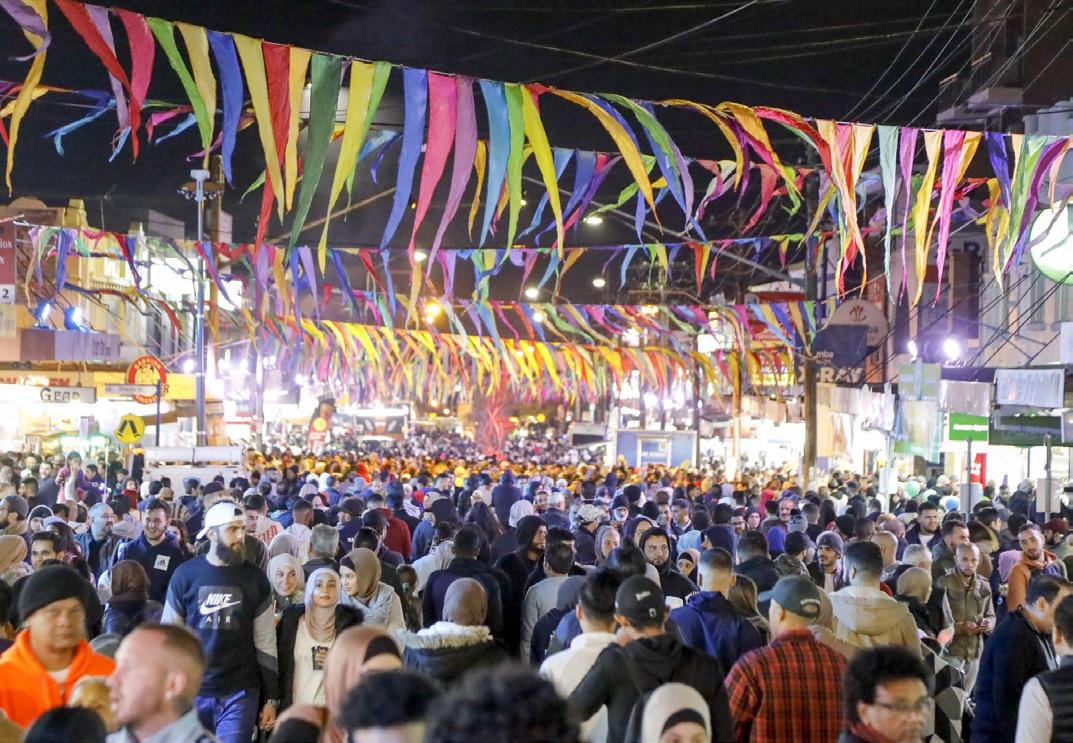
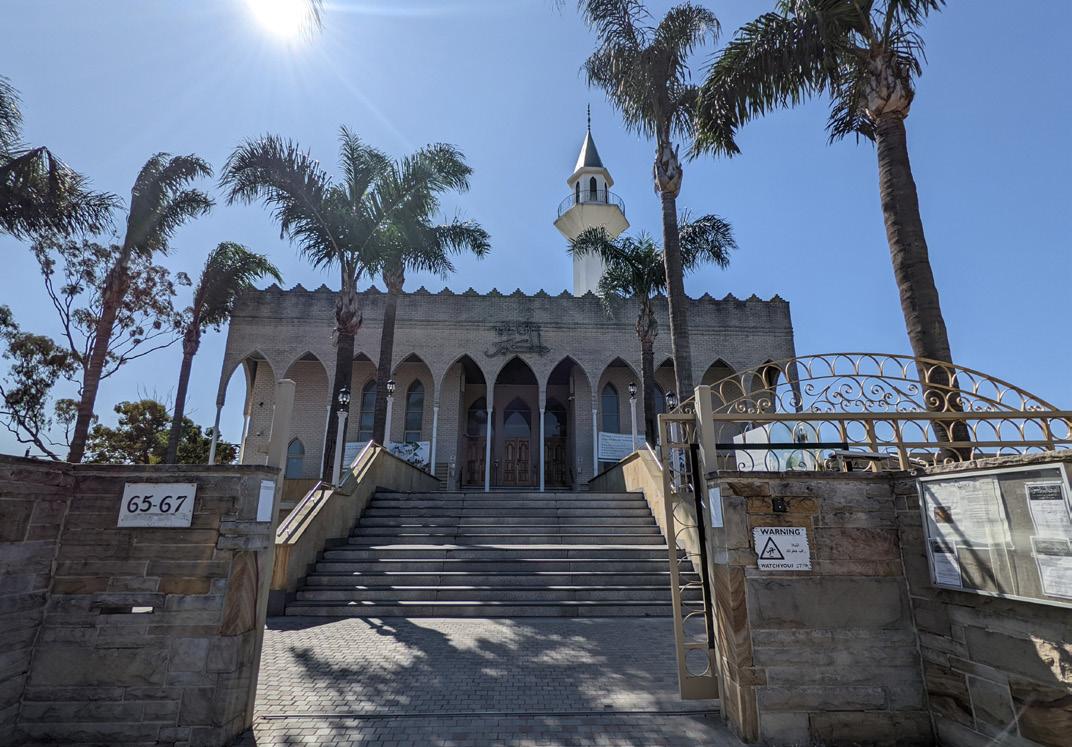
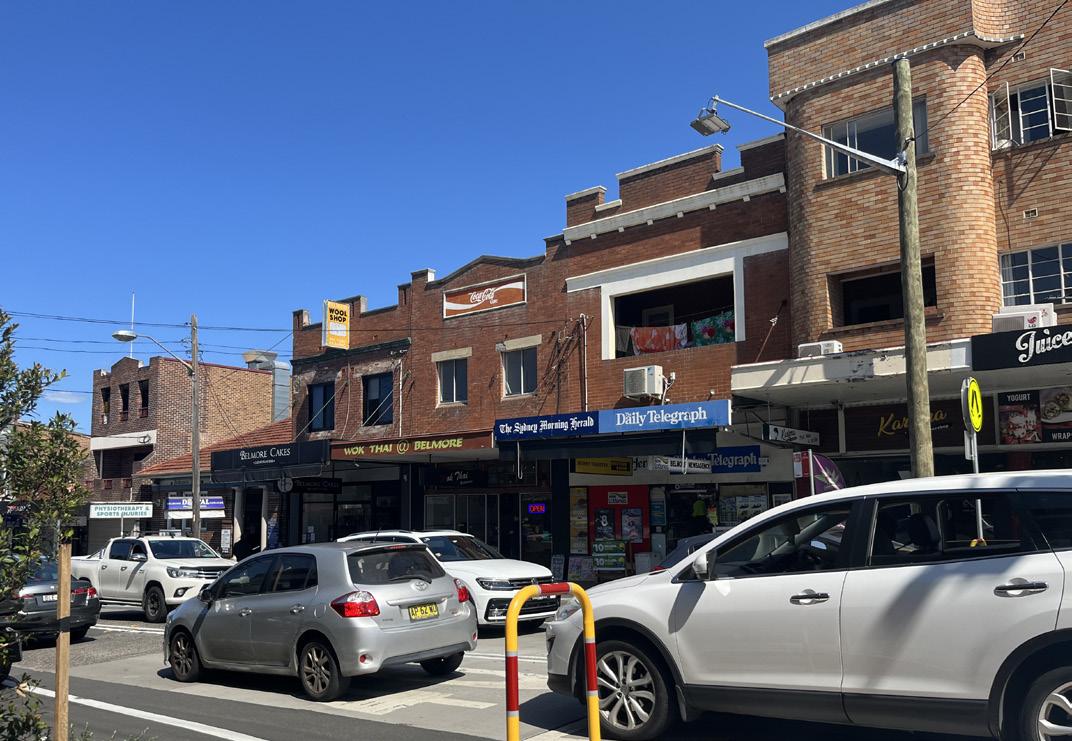
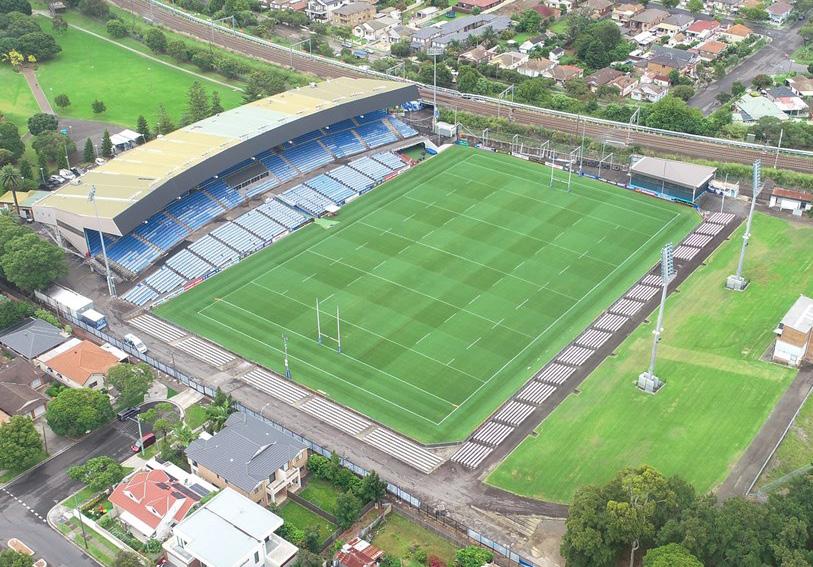
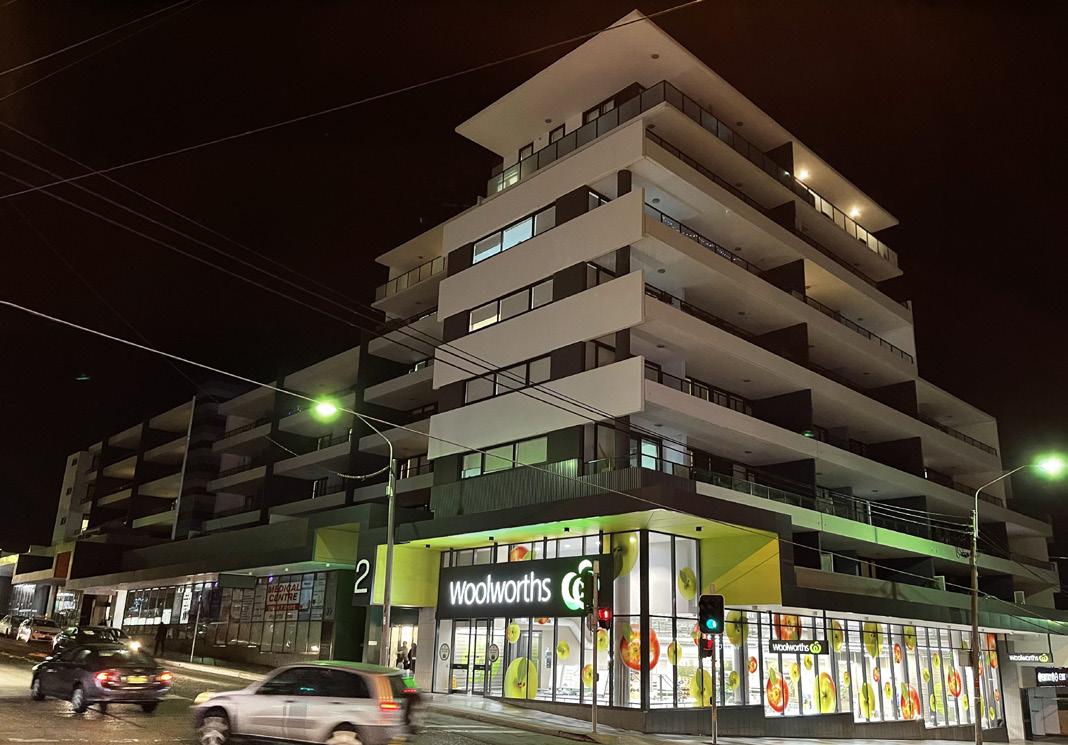

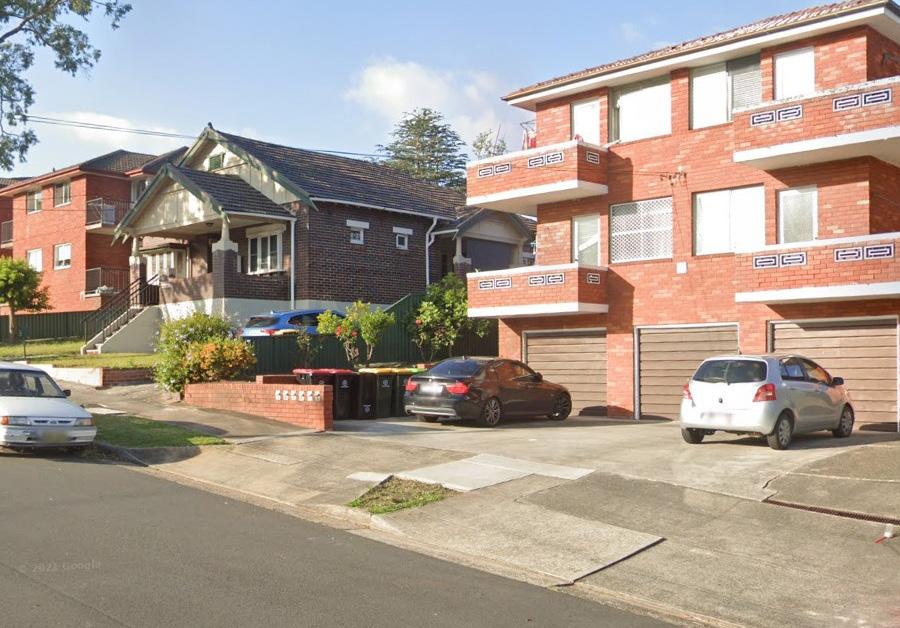
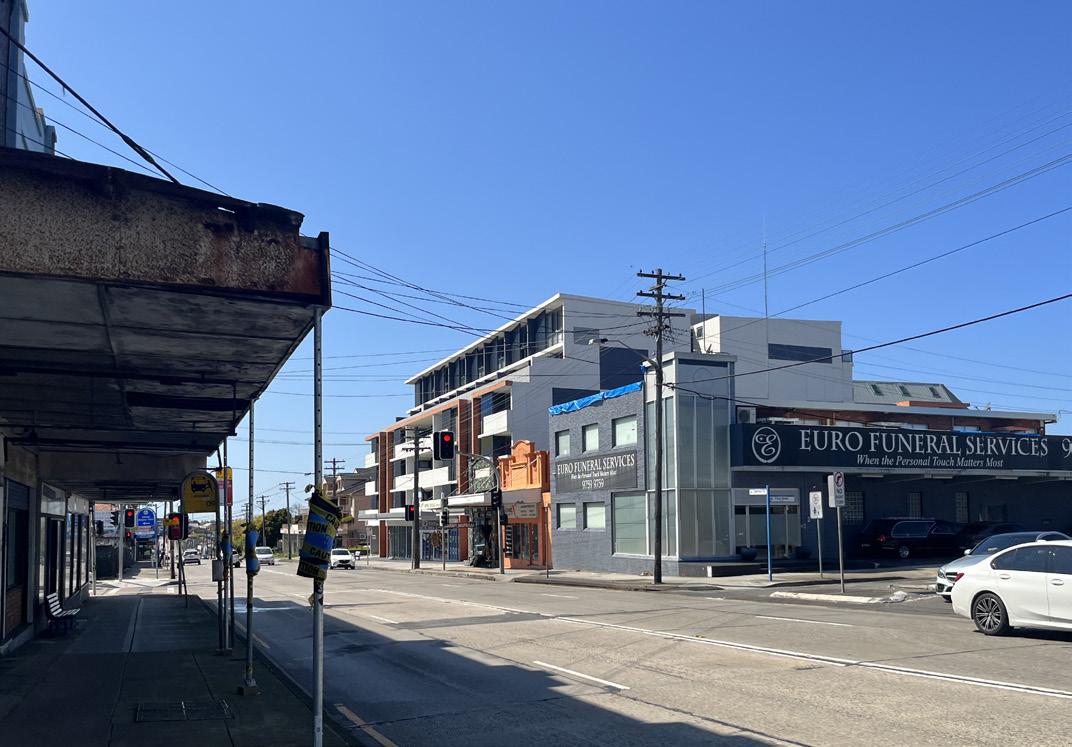

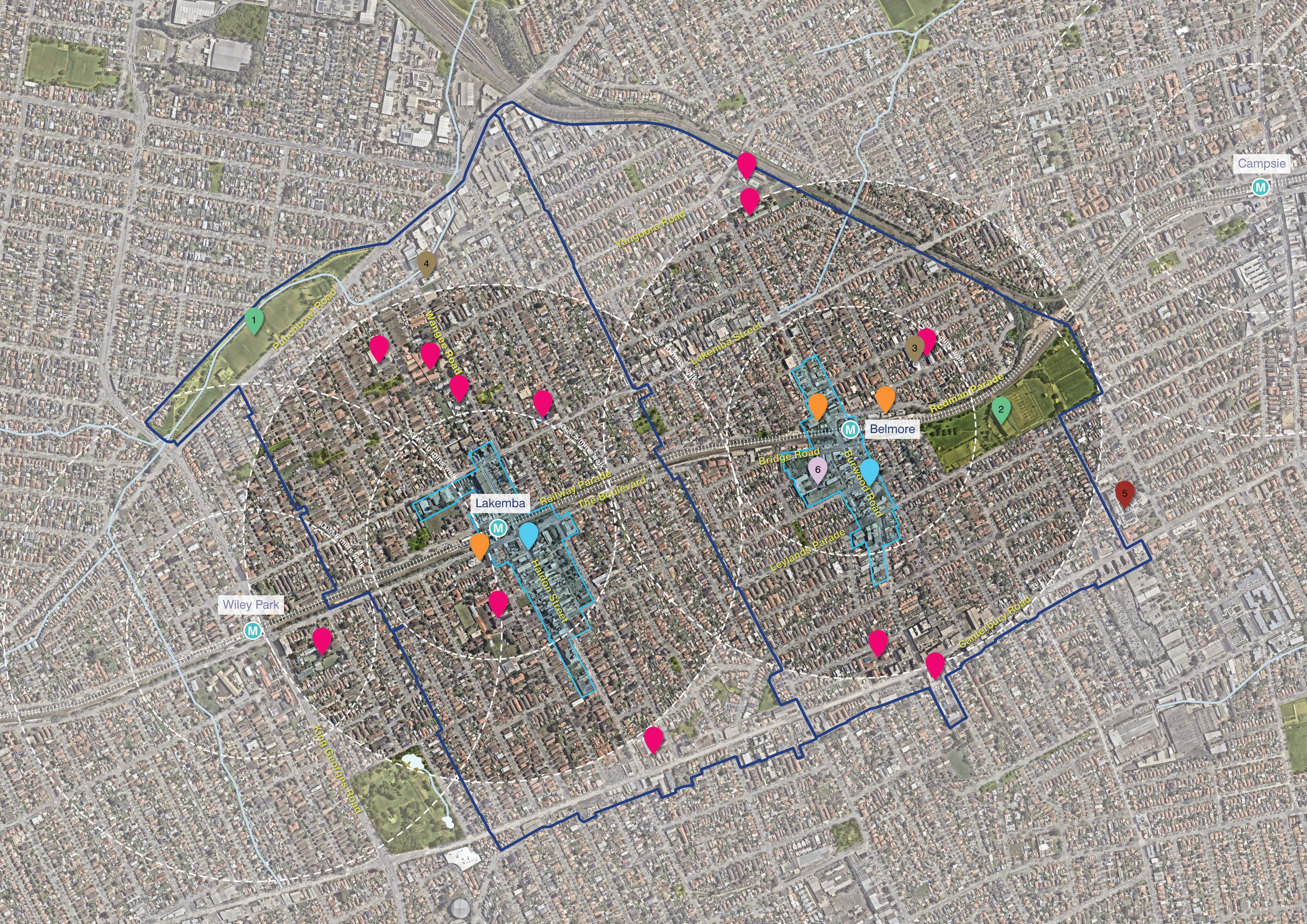
The TOD Program (NSW Government) seeks to increase the supply of new housing in welllocated areas around transport hubs and is comprised of two parts:
Part 1 - DPHI-led accelerated zonings for 8 precincts, and
Part 2 - new planning controls for land within 400m of 37 stations across NSW.
Belmore and Lakemba are both precincts that fall within Part 2 that are being prioritised under the new TOD SEPP. Since the controls take a one size fits all approach, Councils are able to review and propose revised controls for their precincts so long as they can meet or exceed the expected number of dwellings under the TOD SEPP.
The low- and mid-rise housing policy aims to fill the gap between detached homes and high-rise apartment buildings, increasing housing choice while also preserving local character.
The new suite of planning controls will allow a range of low-rise housing in R2 zones (dual occupancy, terraces and manor homes), which forms the first stage of the policy implemented in July 2024, and midrise 3-6 storey apartments and mixed use development in R3 and R4 zones, which forms the second stage of the policy.
The details and and implementation for the mid-rise controls are in development.
As part of the development of the master plans for Belmore and Lakemba, the proposed controls under the TOD and LMR program were tested. Key findings include:
· High level built form testing suggests that the proposed 2.5:1 FSR under the TOD program may not be achievable within a 6 storey height limit. Particularly for residential zones, a 6-storey building would fall well short of the 2.5:1 FSR, generally achieving an FSR range of 1.5:1 - 1.9:1. This suggests that the height limit may need to be exceeded to achieve the FSR.
Similarly, under the LMR controls, the FSRs of 3:1 and 2:1 are unlikely to be achieved within the proposed maximum building height.
· Within B2 zones, given the large site coverage and mix of retail and residential uses, the proposed FSR and height may be achievable.
· Development and environmental constraints such as strata title, heritage, schools, places of worship, isolated lots, land ownership pattern and flooding should be considered to understand a more 'realistic' development potential within the nominated areas under the TOD and LMR controls.
The types of centres nominated as part of the TOD program range from local centres, to larger urban centres, to regional centres. As such, a one size fits all approach may not be appropriate for all centres. Additionally, as shown in the diagram adjacent, the TOD and LMR controls may be applicable to the majority of both centres.
There is an opportunity as part of this process to reconsider the approach to built form height, density and character that better responds to the unique strategic, built form, environmental and place context of Belmore and Lakemba.

Land where TOD and LMR controls may apply under the TOD and LMR program
Summary of TOD controls - RFB and shop top housing
Feature Control
Permissibility R1, R2, R3, R4, E1 (B2) zones
Target area within 400m of the station
Floor space ratio 2.5:1
Building height 22m / 6 storeys (RFBs) 24m / 6 storeys (shop-top housing)
Lot size No minimum lot size
Lot width Minimum 21m
Affordable housing 2% for developments with minimum 2,000sqm GFA
Summary of LMR controls - mid-rise RFB and shop top housing
Feature Control
Within 400m 3:1 maximum floor space ratio
21m maximum building height
Within 400-800m 2:1 maximum floor space ratio
16m maximum building height
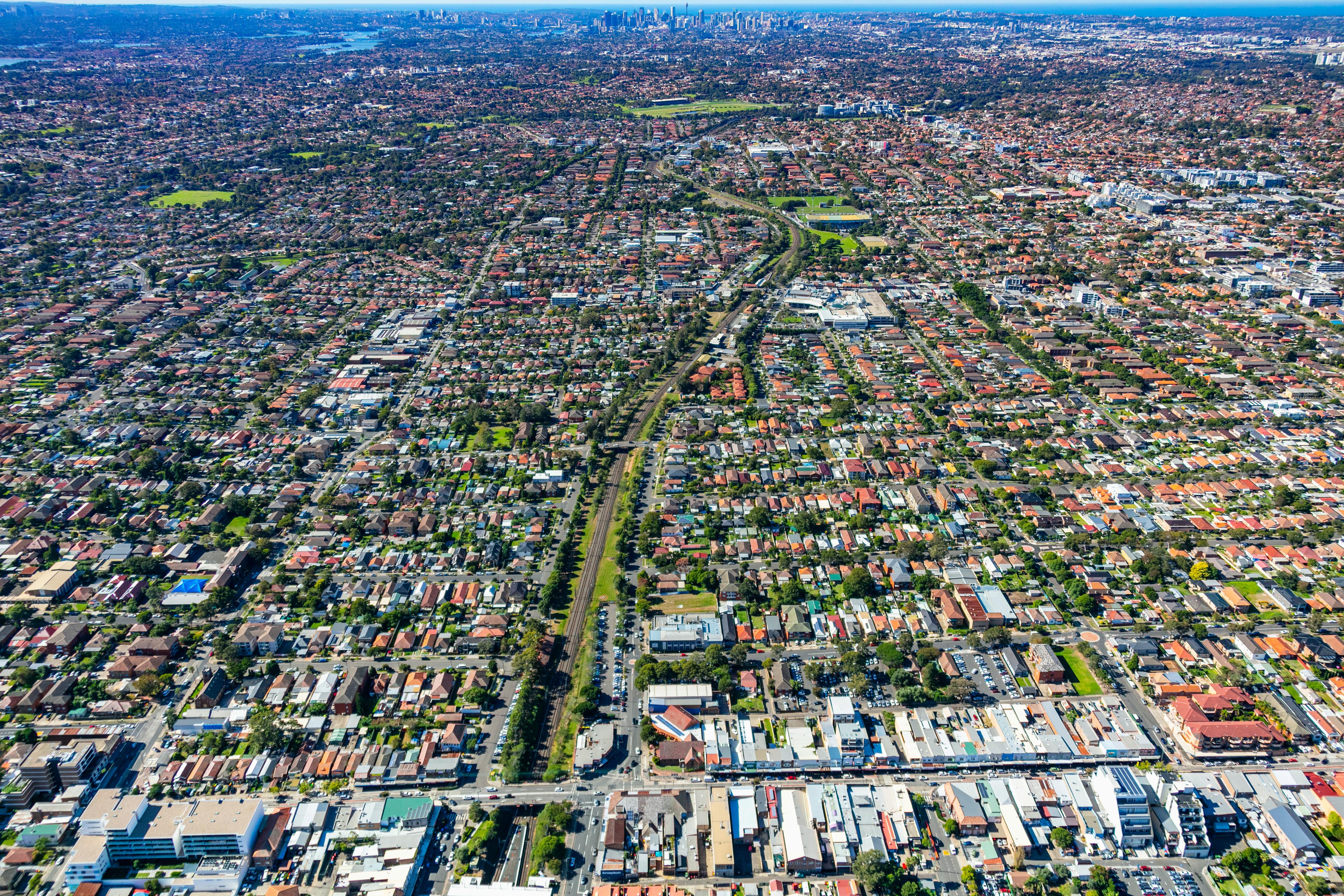
· Some areas within the industrial zones, along the drainage channels, Belmore Sports Ground, Lakemba Street and some existing R4 zones, may become impacted by significant flood events. There is therefore the need to avoid intensification and potentially prohibit sensitive land use in these areas.
· Areas along the rail corridor, particularly to the north of the Sports Ground, along Bridge Road and The Boulevarde/ Sproule Street are susceptible to ponding events and may not be suitable for increased residential development or sensitive land uses.
· Despite the benefits of the Belmore Sports and Recreation Precinct, the size of the open space, poor interfaces, along with the barrier that the railway corridor poses, limits connectivity to public open space within the eastern part of Belmore.
The height, bulk and scale of development will need to be considered, particularly adjoining public open space, where it may cause overshadowing impacts.
· There are areas to the southwest and northeast of Lakemba that are outside the access benchmark to local and neighbourhood open space. Some of these areas are located beyond a 10-minute walk of the station and may not be targeted for residential uplift, which may limit the ability to deliver new open spaces through urban renewal mechanisms.
The current tree canopy and urban heat conditions are below the CBCity LSPS benchmarks generally across the centre. Increasing deep soil, tree canopy and vegetation will rely on both the private sector through development and the public sector through public domain and open space enhancements.
· The rail corridor is a barrier to north-south connectivity, with currently only 3 pedestrian and vehicle crossings, and an additional pedestrian-only underpass near the Belmore Sports Ground.
· Both the main streets, Haldon Street and Burwood Road, play a dual role as the main north-south vehicular and public transport connection across the centre, while also being the main retail spine and heart of the centres. A balance between pedestrians and vehicle access and parking will need to be considered.
· Potential increased vehicular congestion particularly around the main street needs to be addressed through measures that incentivise active and public transport, such as reviewing parking requirements on sites that are within 400m walking distance of the station, and improving public domain amenity and infrastructure for walking and cycling.
· There a number of long blocks, over 400m, currently without mid block connections, which impacts east-west permeability through the centre.
· Lots along Haldon Street and Canterbury Road are currently serviced by an incomplete laneway network which creates issues for servicing and vehicle movement. This may lead to further issues down the track as the centre intensifies.
· The lot pattern within the B2/E1 main street on Haldon Street and Belmore Road consists of fine grain, narrow lots. Redevelopment may be limited unless larger lot amalgamation occurs.
Given the street pattern, large areas along the north and south of Belmore and Lakemba are beyond an 800m or 10-minute walking distance to the station. This may impact the desirability and suitability of increased density within these areas.
A large area within the northwestern corner of Lakemba currently consists of 3 to 4 walk-ups with greater than 4 apartments, which makes redevelopment potential less likely. This also occurs in other areas of Lakemba and Belmore to a lesser extent.
· There are discrepancies between the objectives for high density housing and low rise building height and floorspace ratio controls.
· The Canterbury Road Review proposes to make prohibited residential uses outside the identified localities and junctions.
There is a need to implement appropriate lot size and frontages controls to encourage new development and ensure high quality built form, streetscape and deep soil outcomes are achieved.
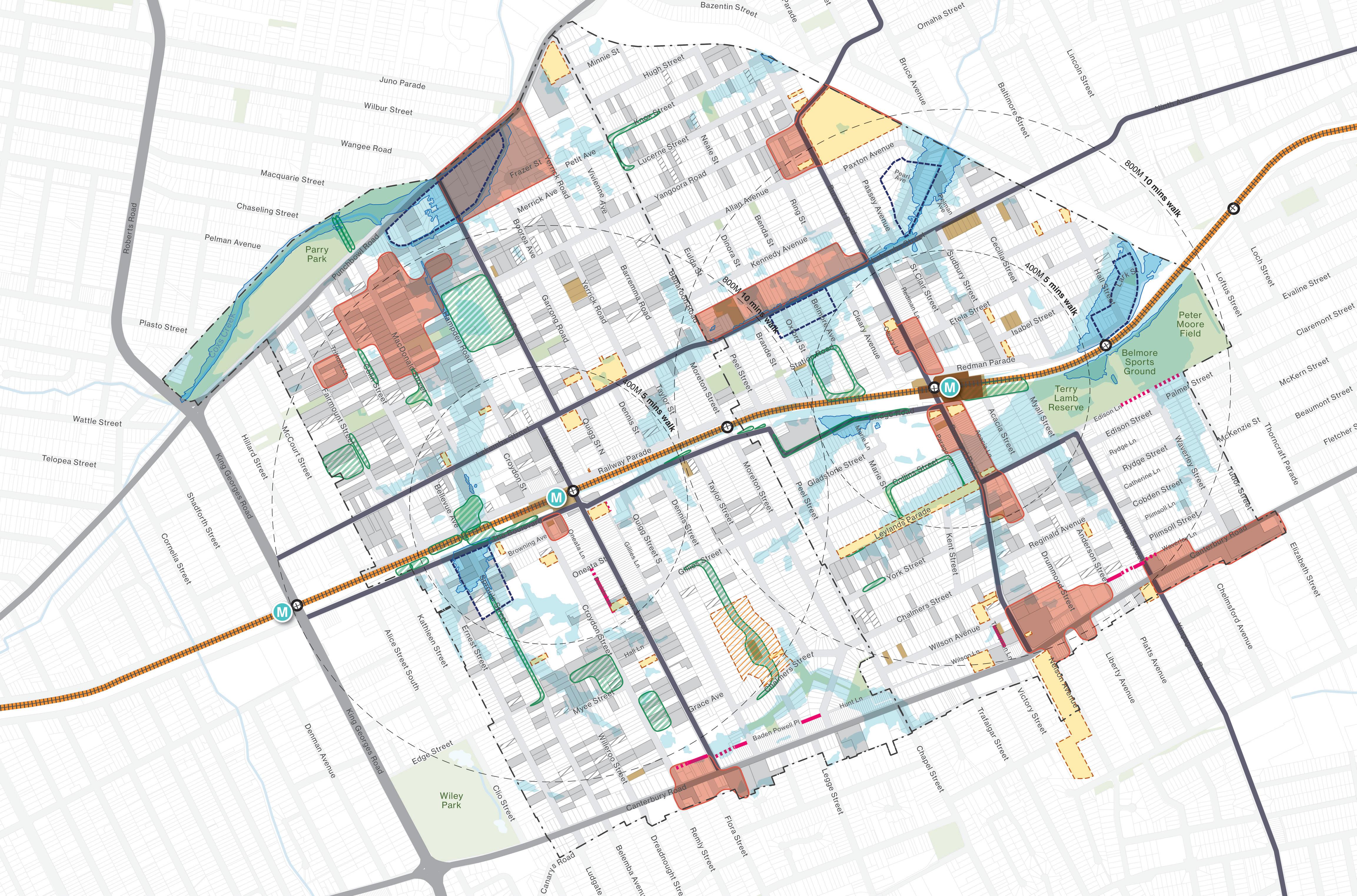
Belmore and Lakemba local centre boundaries
Rail corridor
Crossings over rail corridor
Regional connector
Key roads
Strata title lots with 4 apartments or less - greater likelihood to redevelop
Strata title lots with greater than 4 apartments - unlikely to redevelop
Areas of severe urban heat (greater than 9 degrees above baseline)
Areas with greater than 30% tree canopy
1 in 100 year flood extent
1% AEP provisional flood hazard - high
Flood island
Existing State heritage item
Existing local heritage item
Proposed local heritage item
Proposed heritage conservation area
Service lanes less than 6m wide
Incomplete laneway network
· Develop design guidelines to ensure that future renewal contributes to meeting tree canopy targets identified in key policy documents.
· Provide enhanced street tree planting along key east-west and north-south streets, and generally provide increased amenity for pedestrians and residents on all streets.
· Deliver the Belmore Sports and Recreation Precinct Master Plan and improve access and linkages to the precinct, particularly the connection the station, main street and Leagues Club.
· Deliver the Parry Park Master Plan and improve passive and active recreational facilities, and connectivity to the park.
· Investigate opportunities for new open space on surplus land along the rail corridor, or opportunity sites that can offer publicly accessible open space.
· Provide new open space through land dedication or land acquisition in areas where there are deficiencies.
· Integrate stormwater management strategies, within public domain upgrades on key streets, including those that can provide combined design and sustainability outcomes e.g. water sensitive urban design.
· Investigate the naturalisation or regeneration of existing drainage channels, including in Parry Park, to improve stormwater management as well as increase biodiversity outcomes.
· Celebrate views to key local cultural and urban landmarks, including Lakemba Mosque and the All Saints Greek Orthodox Church.
· Government and private sector collaboration to deliver the key east-west green connection along the Metro corridor, including active transport, improved public domain amenity and street trees.
· Provide increased bus frequency and improving active transport routes to support service upgrades instigated by Sydney Metro.
Incentivise public and active transport use through lower parking requirements in new development within 400m walking distance of the station.
· Re-allocate space to pedestrians and investigate slower speeds on Haldon Street for improved public domain and community uses.
· Align public domain upgrades with key streets where they provide important connections to key places and spaces e.g. schools, parks, the Belmore Sports and Recreation Precinct and Lakemba Mosque, and other cultural and community facilities.
· Enhance and extend existing cycle infrastructure to connect into the broader cycle network. Key areas include - within and around the Belmore Sports Ground precinct and key Green Grid connections, Lakemba Street, Wangee Road, Leylands Parade, Yangoora Road and Burwood Road.
Provide improvements for servicing and waste collection and vehicle access by extending rear laneways behind Haldon Street and Canterbury Road, through land dedication.
· Celebrate the diversity of the people who live and work in the centre, existing and future, and ensure that they are supported with adequate social infrastructure.
· Reinforce Haldon Street in Lakemba and Burwood Road in Belmore as the main street and heart of the centre. Support street life, cultural diversity and the diverse retail that the centre currently offers.
· Opportunity to better utilise and transform Council-owned land, particularly the car parks behind Haldon Street, for a mix of uses. Potential to provide a new consolidated community and open space precinct within the centre.
Strata title lots with 4 or less apartments may be more likely to be redeveloped for increased housing. Infill development within existing R4 areas may contribute to achieving improved built form, deep soil and tree canopy outcomes.
· Opportunity to target new development in areas close to public/active transport, shops, services and public open space as well as where there is existing density.
· The Leagues Club is a potential opportunity site for new mixed uses given its proximity to the station and main street and being one of the largest sites under single ownership.
· Potential to redefine and enhance the character and amenity of Canterbury Road, particularly at the intersections with Burwood Road and Haldon Street, and provide better pedestrian connections to the main street.
· Industrial areas will be retained, however development should create a positive interface with surrounding residential neighbourhoods, as well as provide adequate buffers for amenity (noise impacts, landscape setbacks).
Identify distinct character areas focused around amenity, including shops, open space and schools.
Preserve and celebrate heritage items and areas of value to the community, including places with great local character.
Improve design quality and beauty of new development through strong principles that guide LEP and DCP provisions.
Increase affordable housing and dwelling typologies to serve all people at different stages of life and abilities.
Belmore and Lakemba local centre boundaries
Planned active transport connection - East West Pedestrian and Cycle Link (Sydney Metro)
Priority street for green connections
New and enhanced through site links
Potential naturalisation and WSUD works on stormwater channels


New and enhanced open space
Target area for investigation for new local or neighbourhood open space
Opportunity for shop top housing in the B2 Local Centre main streets
Opportunity for most intensification close to metro
Opportunity for some intensification around hospital and connecting two centres
Enhance activation and public domain amenity along the main streets
Key sites - opportunity for increased housing with provision of community infrastructure
New community precinct
Mixed use nodes along Canterbury Road
Existing residential areas with attractive landscape, historical and local character
Existing Stage heritage item
Existing local heritage item
Proposed local heritage item
Proposed heritage conservation area
Key community attractors

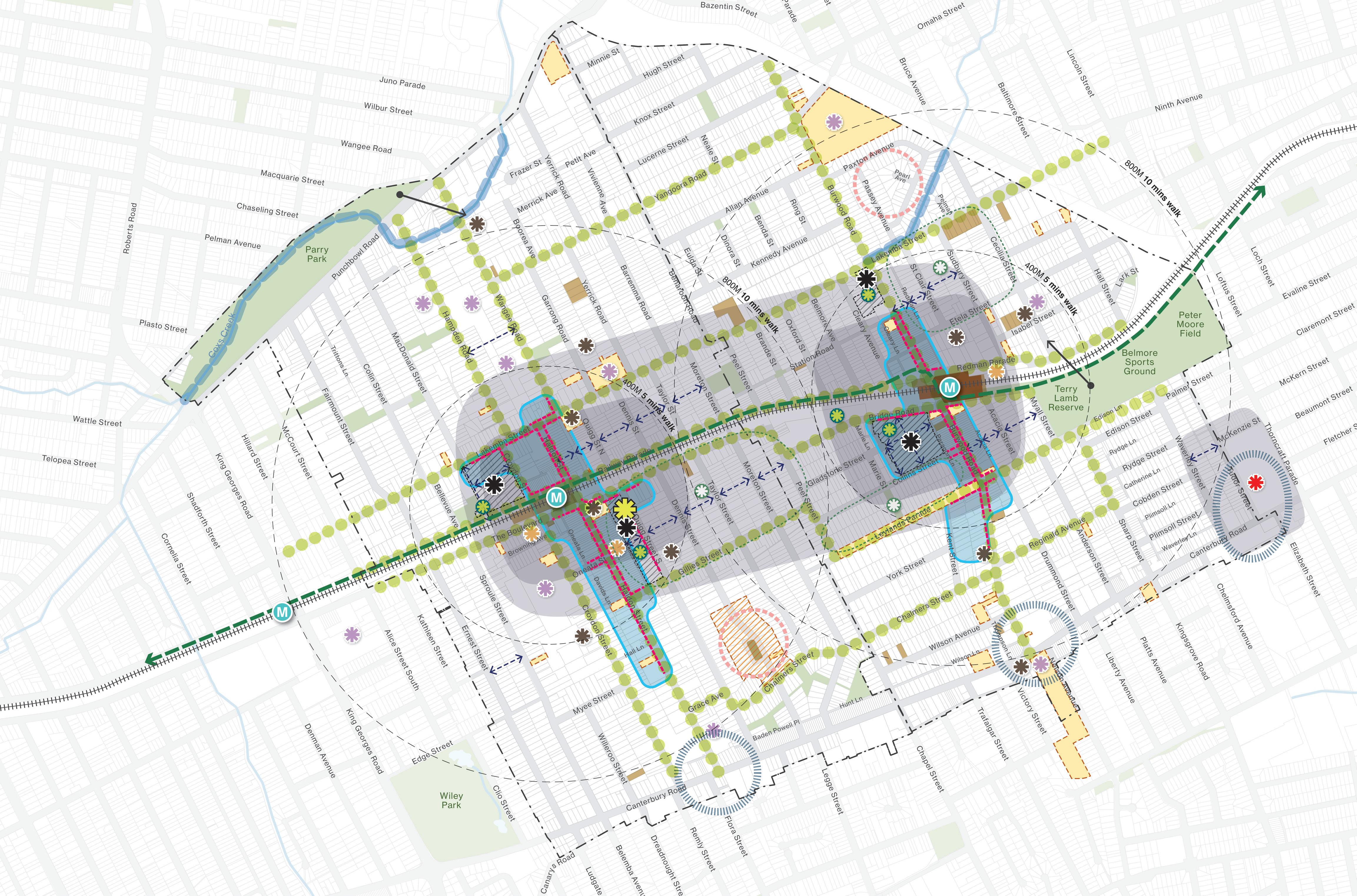
Schools
Places of worship
Community facilities
Canterbury Hospital
An alternative approach to the TOD may address the overarching objective of the TOD program - to deliver increased housing around key transport nodes - while achieving an outcome that is placespecific and considers the unique characteristics and needs of Belmore and Lakemba.
An alternative approach to TOD can achieve the following:
Place-based approach to renewal within Belmore and Lakemba
An approach to height and density that is based on the unique aspects of the local context and character of Belmore and Lakemba, locating new housing in key strategic areas while also retaining and celebrating areas that have great local character.
'Realistic' approach that takes into consideration existing constraints
The approach to renewal needs to take into consideration existing development and environmental constraints that may make some areas inappropriate for new housing or increases in density. This may include strata title, heritage, schools, places of worship, isolated lots, land ownership patterns and flooding.
Plans for future growth within the centres holistically, instead of focusing uplift within 800m
There is potential for increased housing beyond the 400m - areas within a 10-minute walk to the station is considered reasonable. There are also opportunities for moderate uplift in other areas that may have great amenity and access to services and key attractors.
Allows for variations in height and density that is context-responsive
Rather than a blanket 6-storeys within the 400m radius under the TOD controls, an alternative approach may allow for a well-considered and tested built form strategy that locates increased height and density in the right places while preserving the character of other areas, and ensuring that there is adequate built form transition of height and scale.
Ability to align community infrastructure and public domain enhancements with increased housing
Community infrastructure provision and open space and streetscape upgrades can be targeted in areas that need it across the centre, and new development may help deliver these initiatives. This will be essential to ensure that Belmore and Lakemba remain places that people love to live and work in.
Able to deliver more housing across the centre than the TOD program
An alternative master plan approach to the TOD may deliver more housing across both centres than the TOD program and contribute to realising its strategic potential. The approach can also deliver greater housing diversity, more affordable housing, and better design quality for new buildings.

Our alternative approach is based on a clear vision for Belmore and Lakemba:
Belmore and Lakemba Local Centres will be places with vibrant street life where our communities can come together and celebrate their cultural diversity.
The centres will provide greater housing choice to cater to the diverse needs of our communities. New buildings will be well-designed, in ways that respond to Belmore and Lakemba's unique character, provide sensitive interfaces and transitions between low-rise areas and heritage, and ensure that new urban areas retains a human scale and community feel.
Growth in Belmore and Lakemba will be supported by enhanced public transport connections, increased retail activity and new services, new walking and cycling links and green walkable streets. Burwood Road and Haldon Street will remain vibrant and interesting high streets supporting a thriving and distinct local business community.
Investment into key parks and community infrastructure including the Belmore Sports and Recreation Precinct, Parry Park and a new community and open space precinct in the heart of Lakemba will ensure the community can enjoy high amenity as the centres evolve over time.
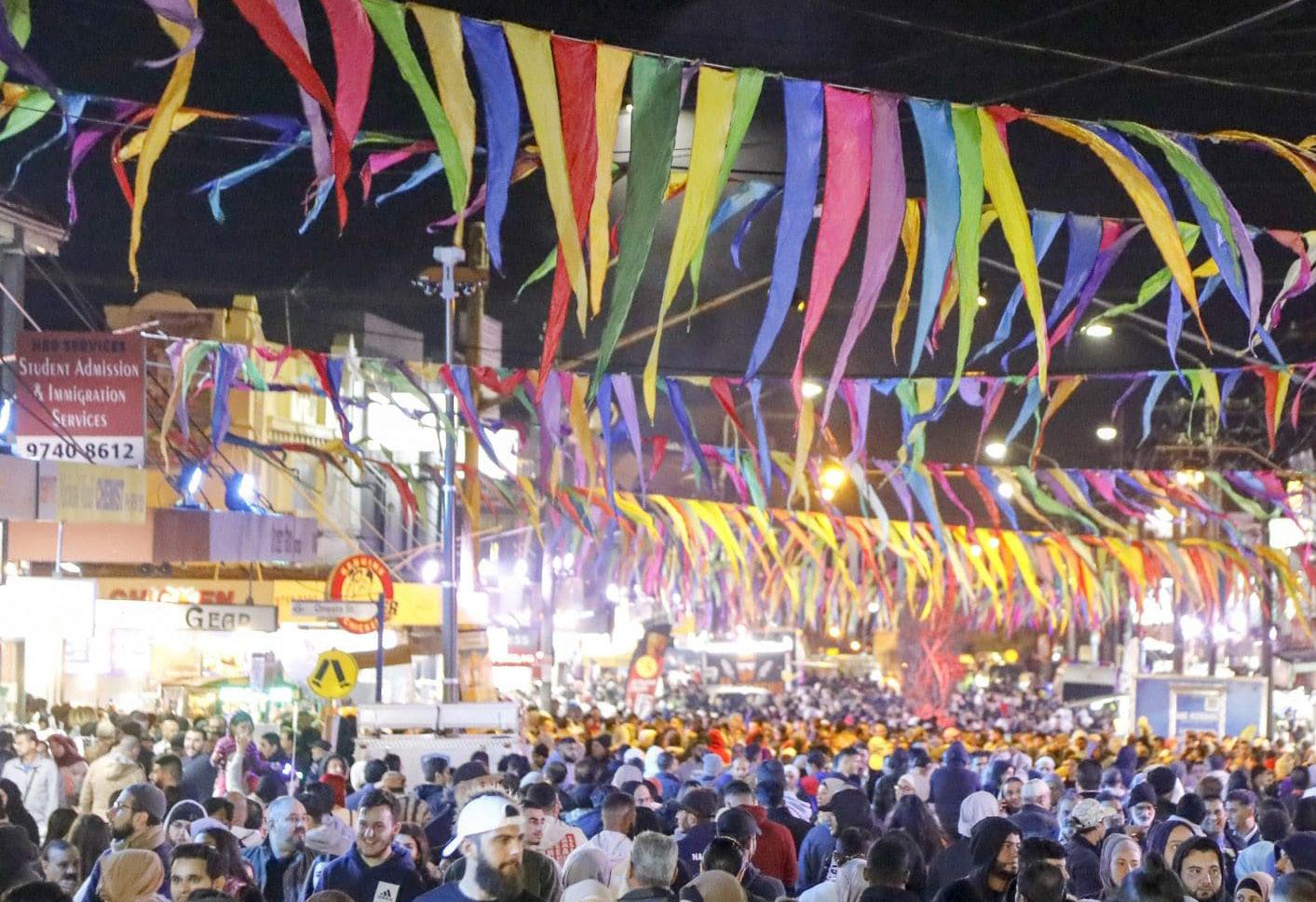
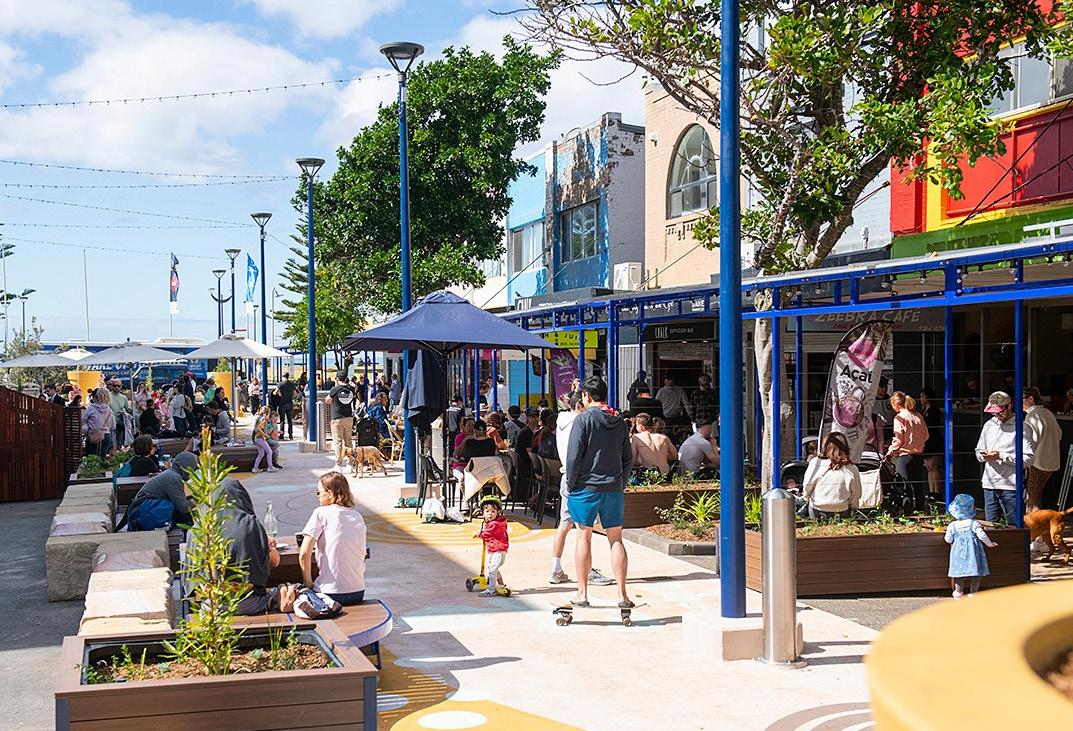
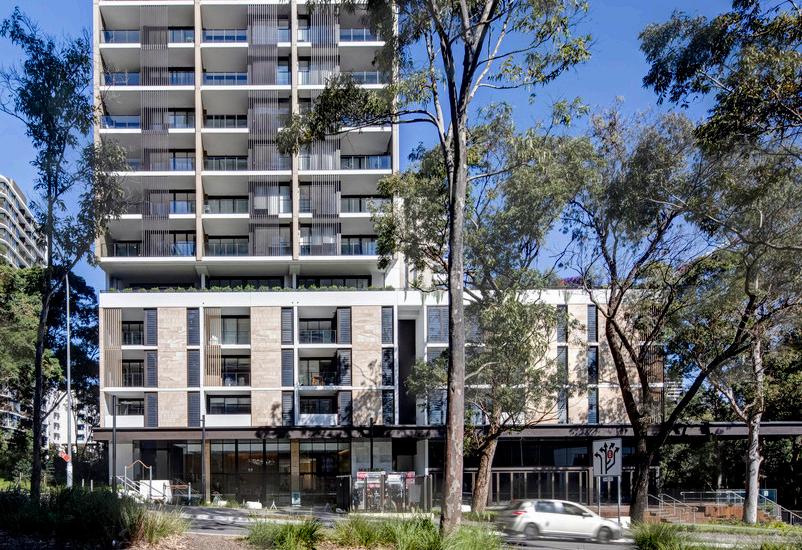
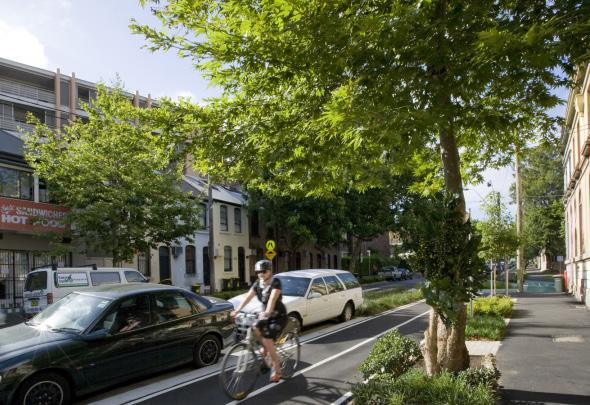
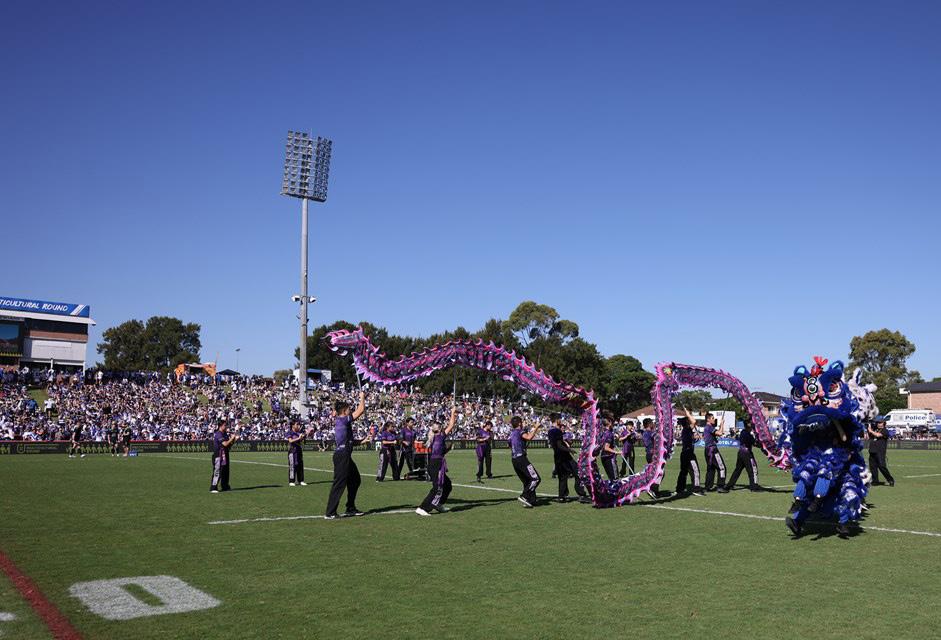
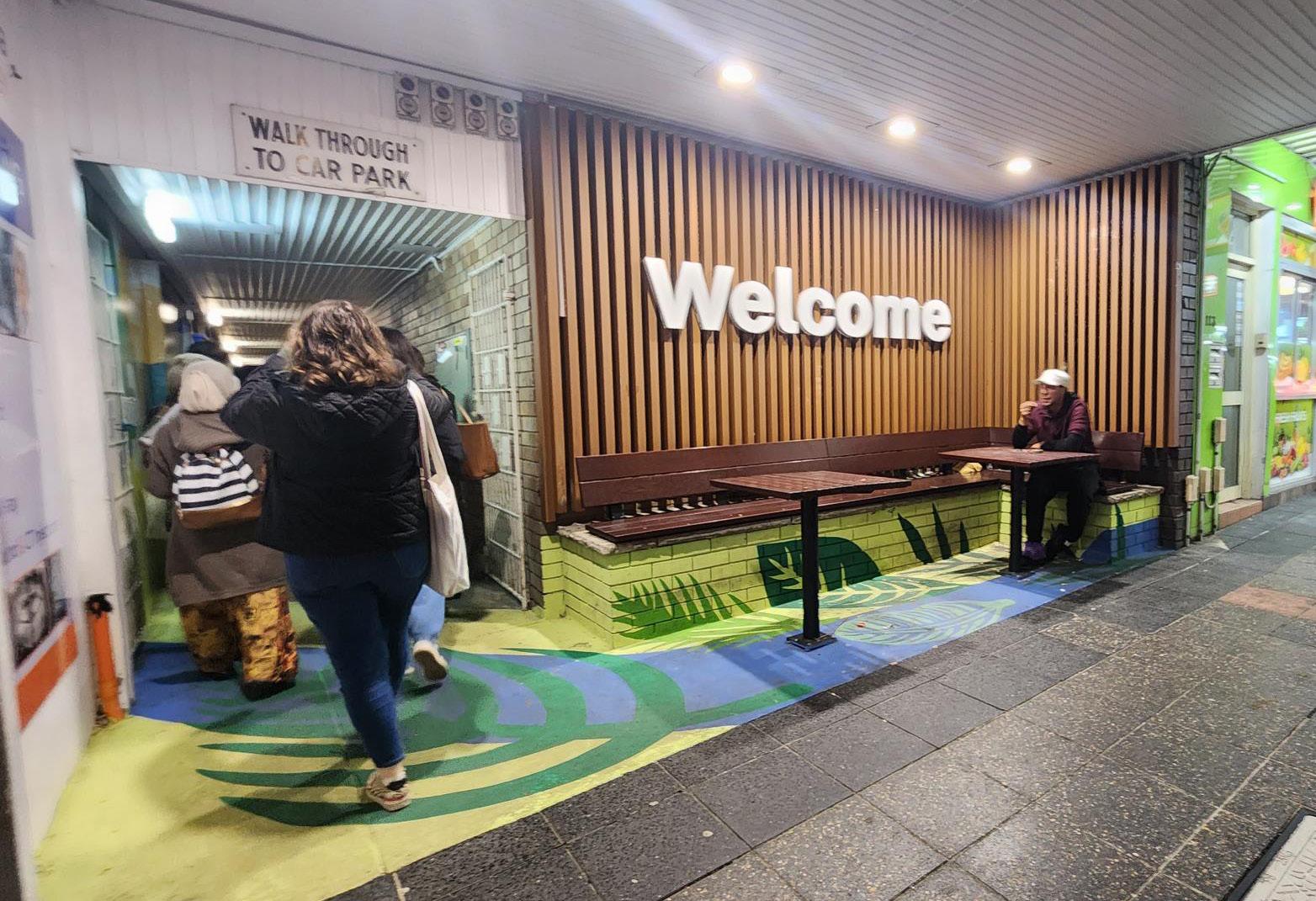

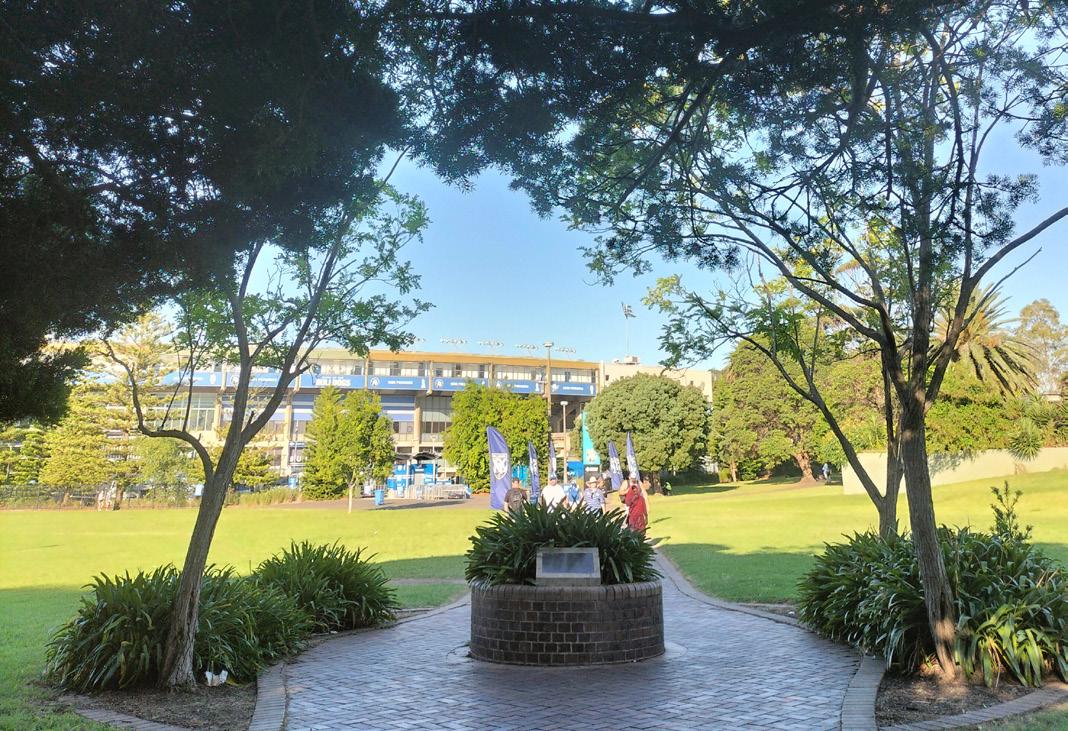
Celebrate and enrich the unique cultural identity of Belmore and Lakemba and ensure that the community is wellsupported through infrastructure (community centres and open space), and festivals.
Reinforce street life through safe, inclusive and activated spaces for the community to gather.
Deliver diverse housing options within the centres supporting a range of demographic needs.
Create attractive, biodiverse green streets, parks and public spaces that are cool and comfortable to walk along and spend time in.
The following design principles guide the overarching place, built form, open space and connectivity approach to the Belmore and Lakemba Local Centres.

Define and celebrate unique character areas
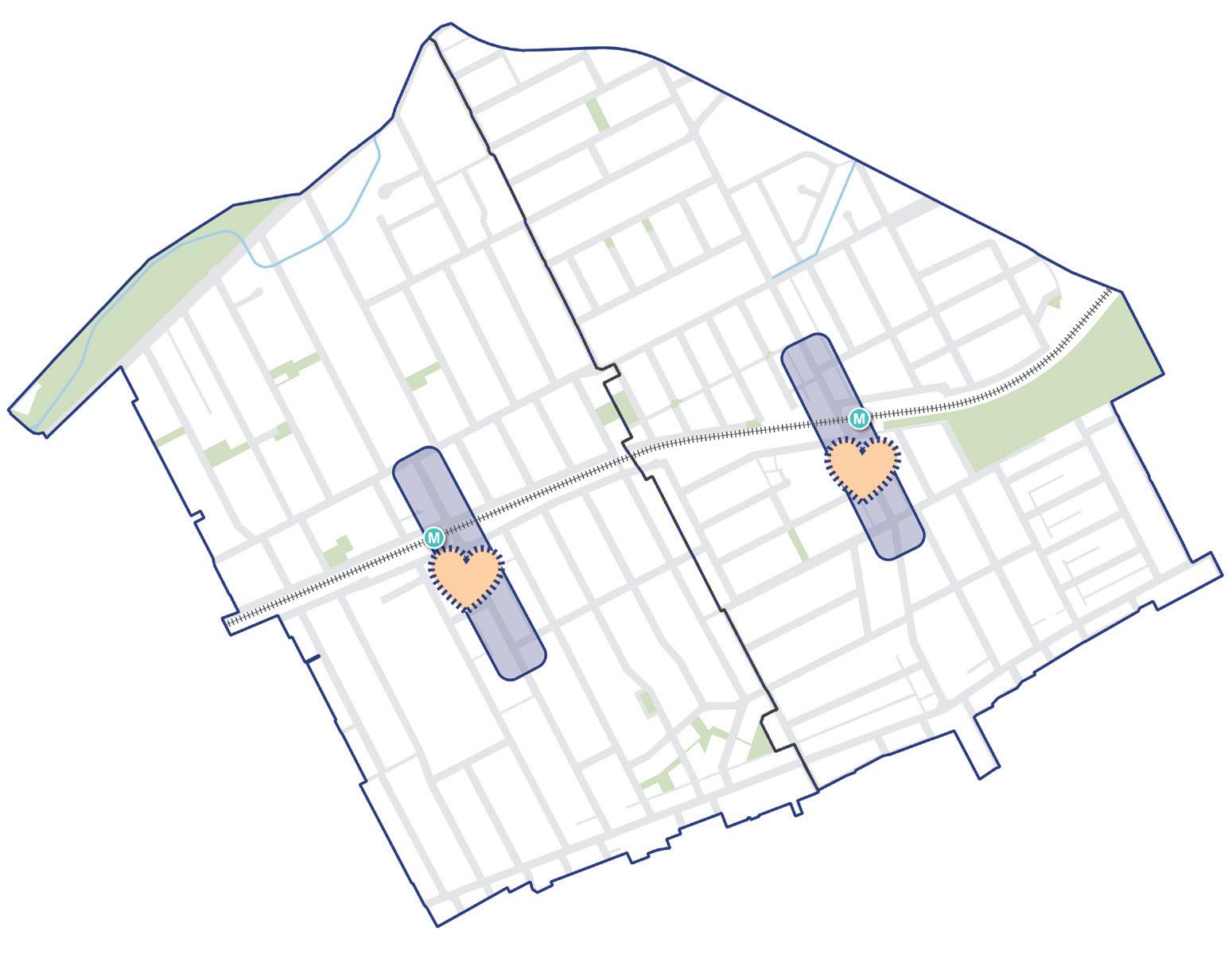
Celebrate and enhance the fine grain main streets as the heart of the community
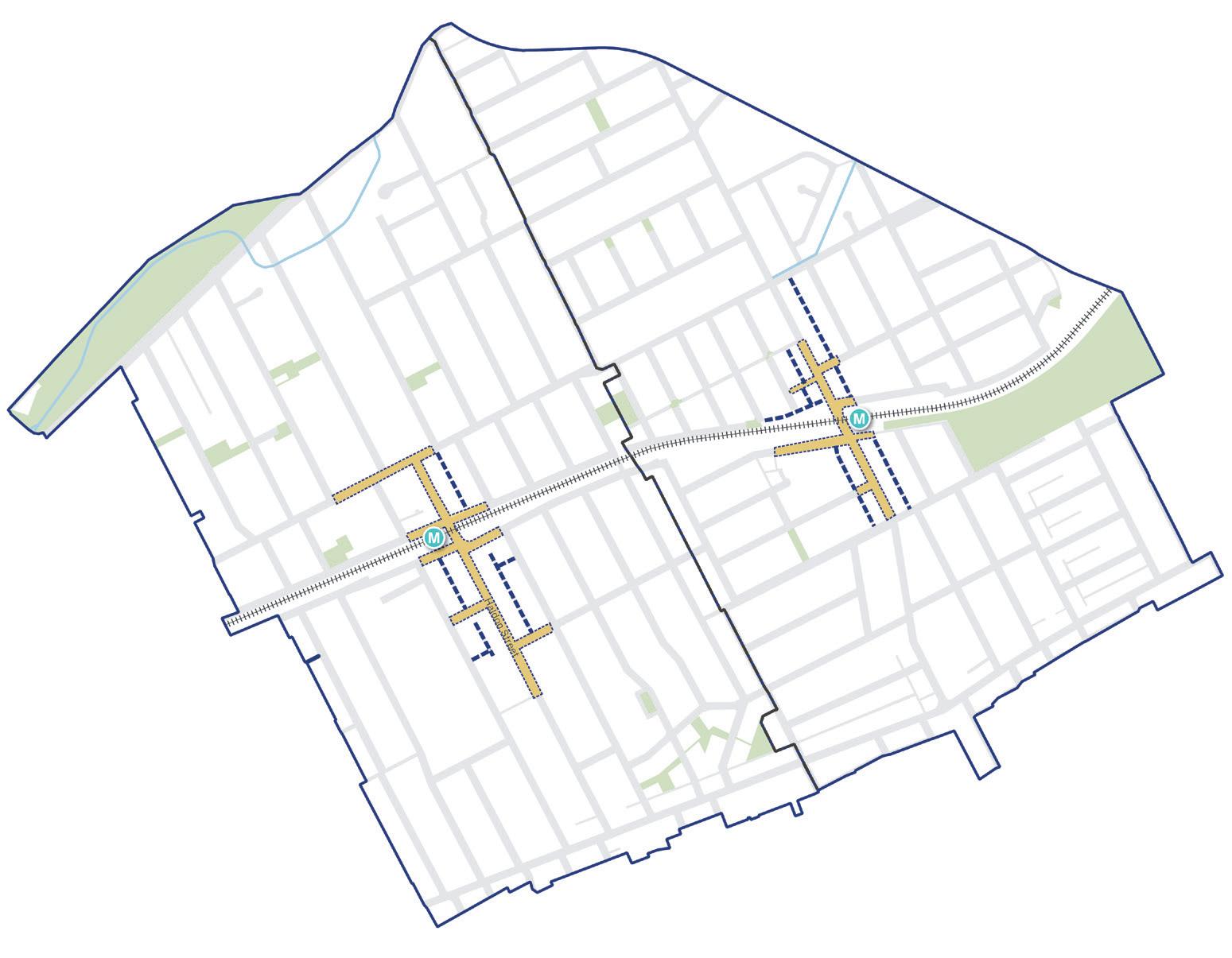
Promote pedestrian activity and enhance the public domain along Haldon Street and Burwood Road
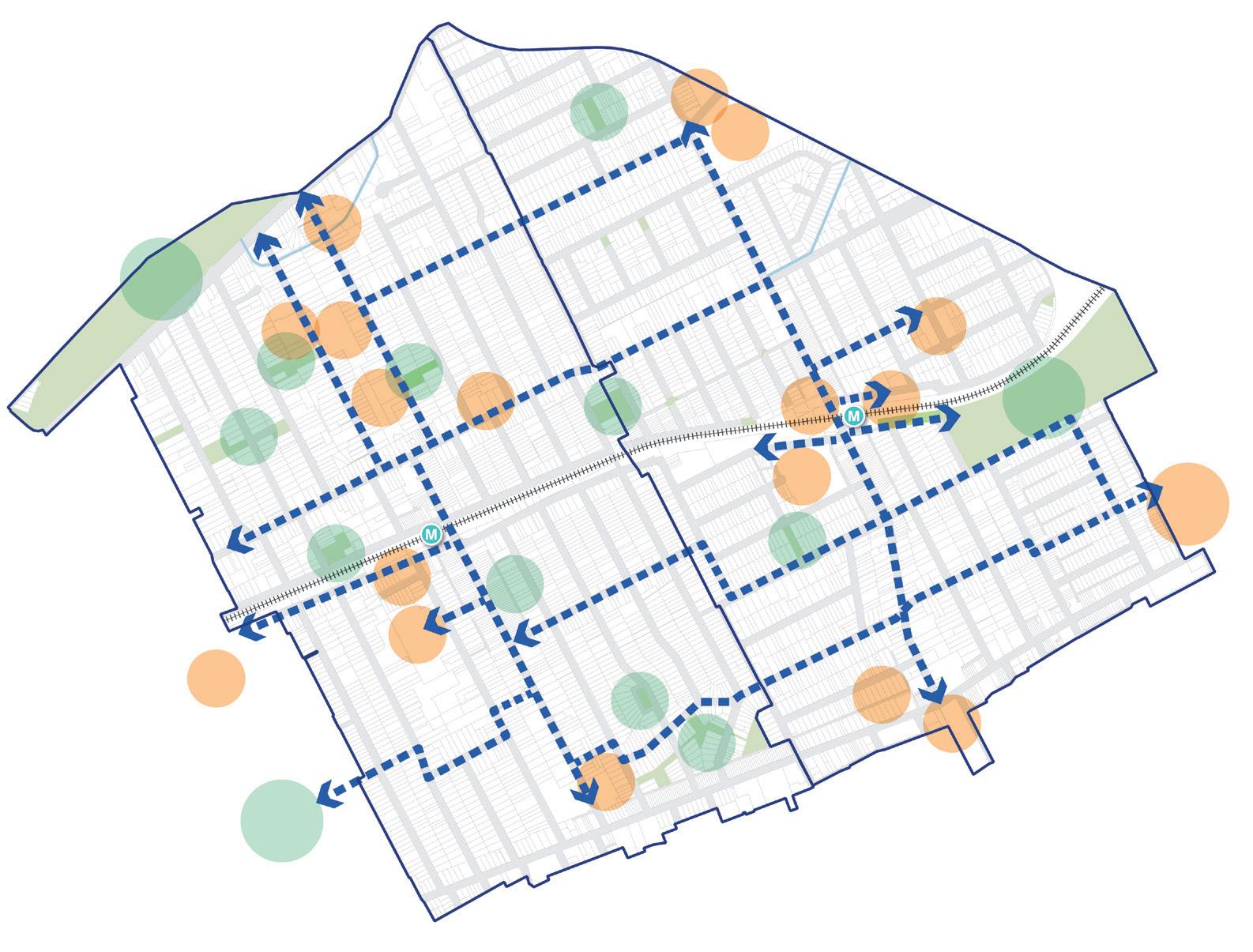
Enhance connections between the station and key parks and community attractors
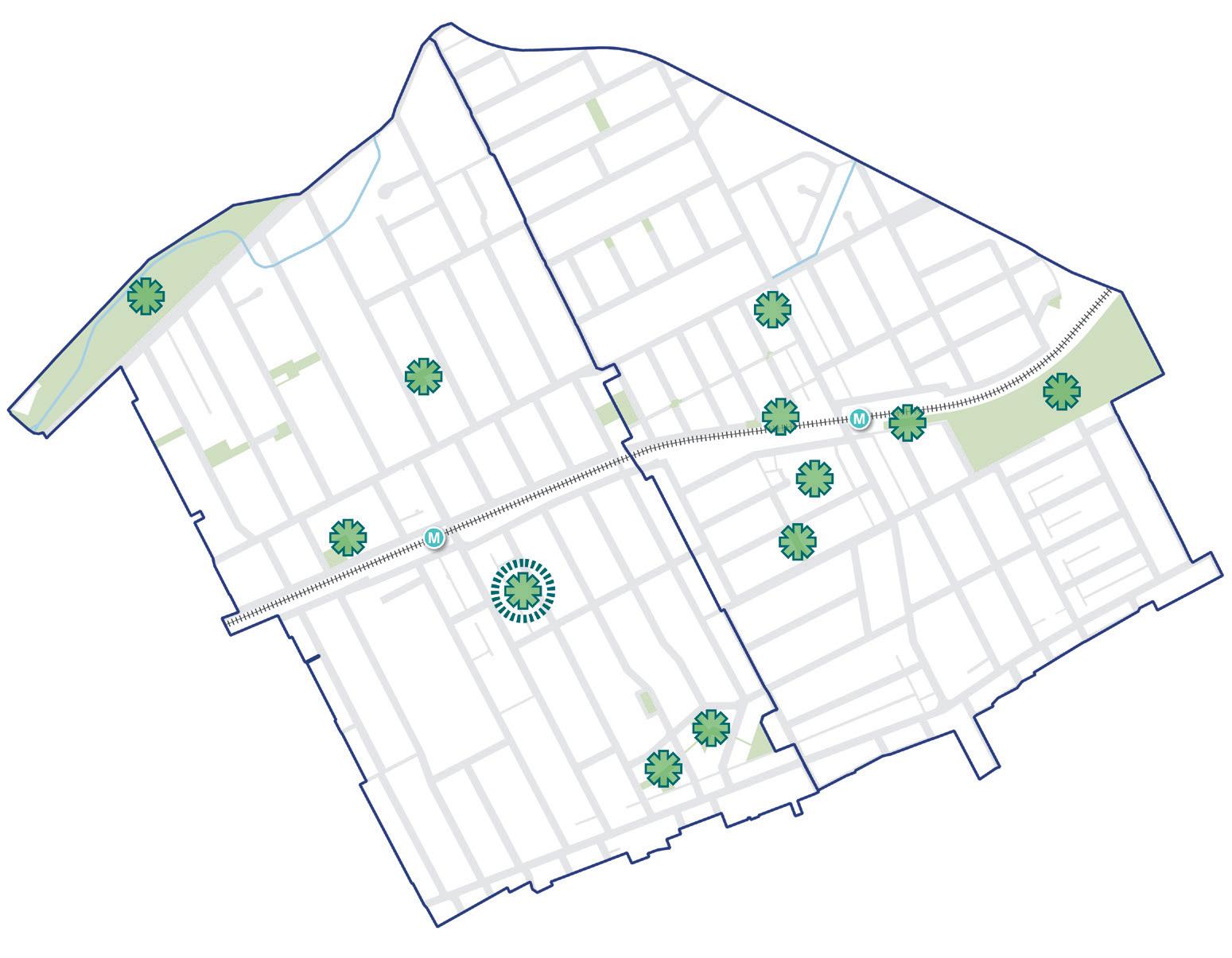
Deliver new and enhanced public open space

Increase tree canopy to create attractive, biodiverse and resilient centres

the connection between the
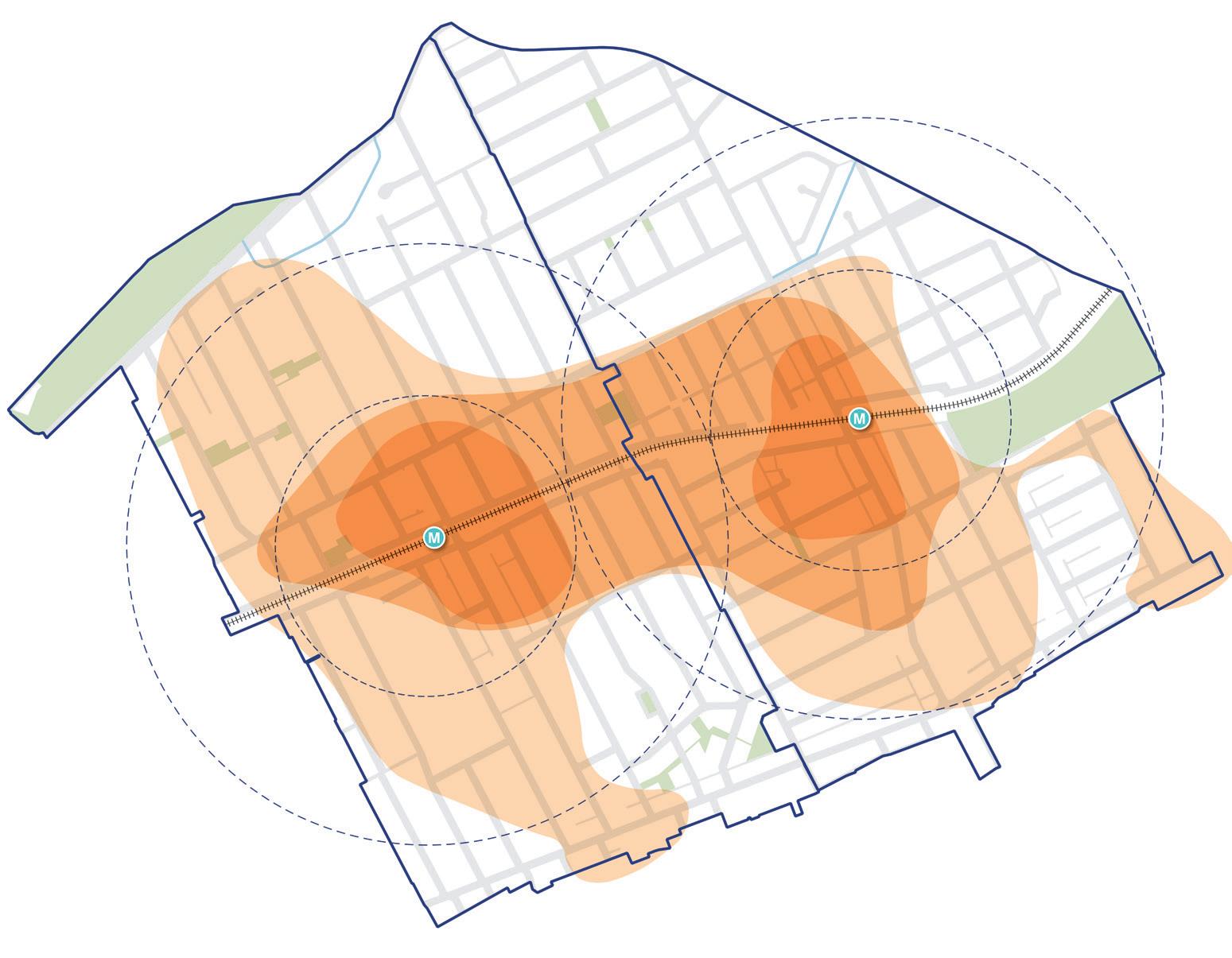
Focus areas for housing within a 5-10 minute walk of
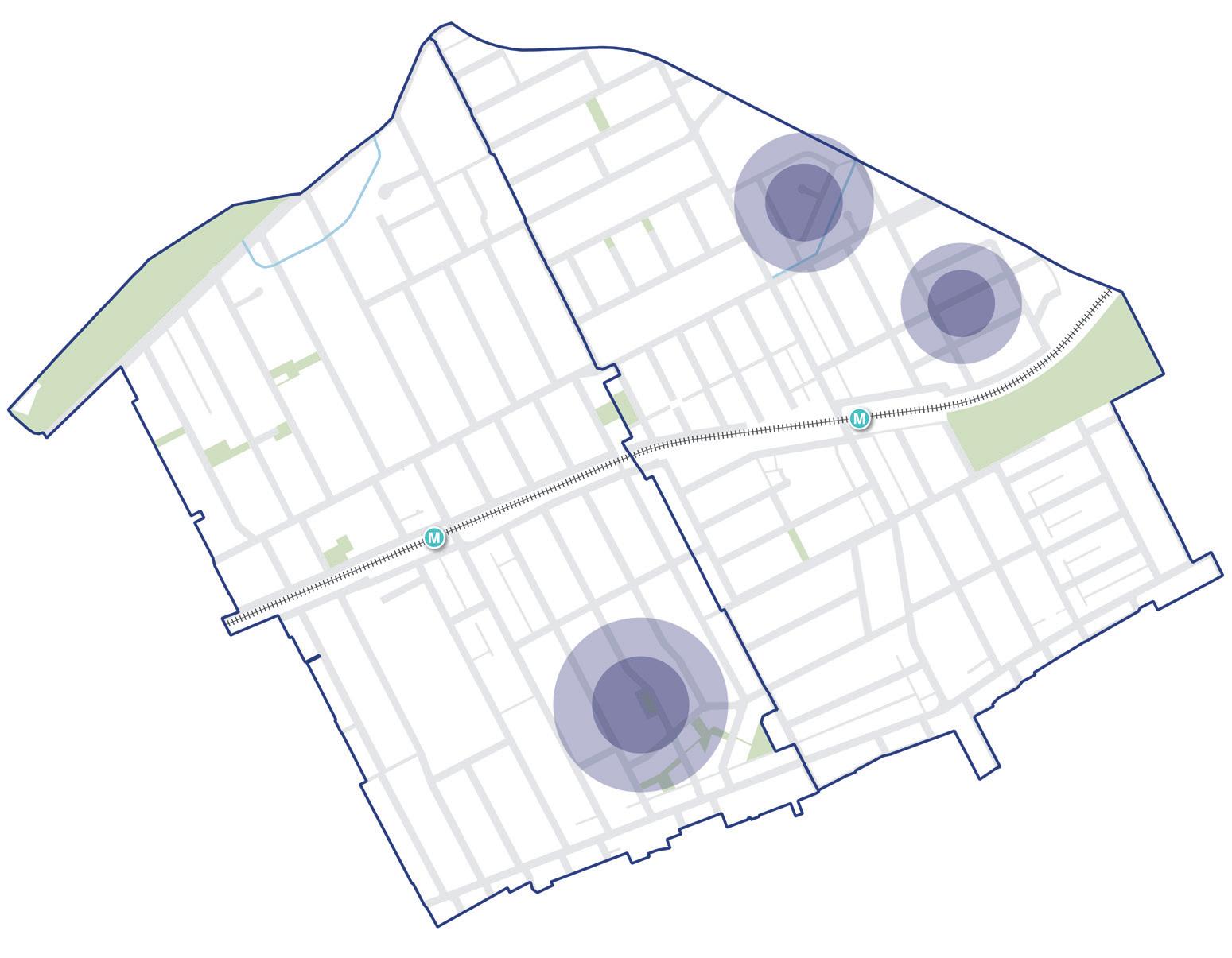
Celebrate and retain areas with great local character
1 Retain and compliment the existing local character of the Haldon Street and Burwood Road main street, while allowing for some new shop top housing and mixed use development up to 6-8 storeys.
2 Increase housing opportunities and focus high density housing up to 9-15 storeys along the rail line, within 5-10 minutes walk of the stations.
3 Opportunity for high density development on key sites that can help deliver new open space, links and community infrastructure, with additional building height varying by site.
4 Support new mid-rise medium density housing in areas within 10m walk of shops, transport or key open spaces, up to 4-6 storeys.
5 Provide opportunity for new housing adjacent to the Belmore Sports and Recreation Precinct and Canterbury Hospital, up to 6-8 storeys.
6 Provide new housing opportunities along Wangee Road, close to schools, parks and cultural facilities, up to 8 storeys.
7 Focus mixed use development on Canterbury Road at defined nodes, up to 6-8 storeys.
8 Support low-rise medium density housing close to shops, transport and open spaces.
9 Retain the unique built form character in key existing low scale areas. Explore opportunities to rezone specific areas to R2 Low Density Residential.
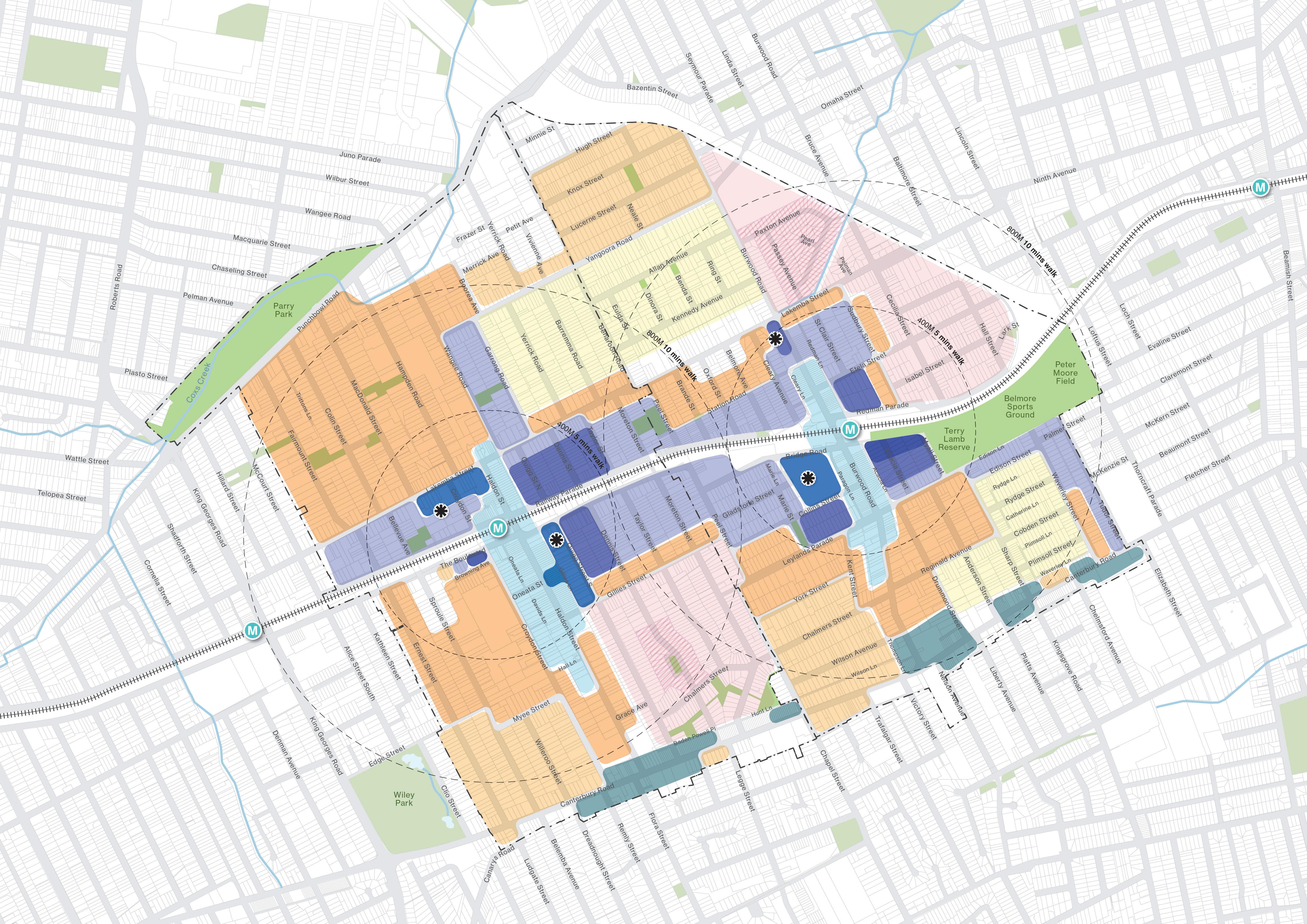
The draft structure plan described on the following pages summarises the approach to land uses, built form height, scale and character, key sites, new and existing enhanced open spaces, through site links and laneways, and existing and proposed heritage items. The draft structure plan will be further developed in response to community feedback to ensure that high quality built form and public domain outcomes can be achieved within the Belmore and Lakemba Local Centres.
· Revitalise Belmore and Lakemba's lively main streets, supporting fine grain retail and moderate mixed use development opportunities up to 6-8 storeys, coupled with public domain enhancements.
· Focus increased housing within a 5-10 minute walk of the station, with residential and mixed use development ranging between 8-18 storeys.
· Identify key sites that have the opportunity to provide community infrastructure such as open space along with a range of uses.
· Allow for modest, mid-rise uplift in areas within a 10 minute walk of the Metro, the main streets, and open space or in existing areas where walk-ups and apartments are common, between 4 and 6 storeys.
Encourage the delivery of moderate renewal in the form of low-rise medium density housing in areas close to open space, shops and transport, while also retaining current low rise planning controls in areas with special neighbourhood character or proposed heritage conservation areas.
Celebrate areas with historical character and identify sites to be added as a local heritage or conservation area listing.
Preserve views to key cultural landmarks such as the Lakemba Mosque and the All Saints Greek Orthodox Church. Support mixed use development and employment uses in targeted areas along Canterbury Road ranging between 4-8 storeys.
· Preserve existing industrial-zoned land along Lakemba Road and in the Punchbowl Road industrial precinct.
· Deliver a new public open space co-located with a new community facility within the 'Quigg St block' key site behind Haldon Street.
Provide new open space on key sites, as well as investigate areas for new open space where there may be an open space deficit.
· Deliver and build upon the Master Plan for Belmore Sports and Recreation precinct that will enhance access, connectivity and provision of a range of sporting and recreational facilities.
· Enhance existing local and neighbourhood parks, including opportunities for expansions to Peel Park, Marie Street Reserve, Anne Pringle Reserve and Harold Bull Reserve, through land dedication or acquisition.
· Provide pedestrian through site links that may be delivered through development, and encourage walkability through the centre.
Enhance the tree canopy throughout the centres, through new development and enhancements to the public domain, to mitigate urban heat island effect and create cool, biodiverse and attractive neighbourhoods.
· Avoid new housing and increased density in areas that are environmentally constrained, including on flood-prone land.
· Investigate the provision of a new public open space on existing flood-prone land along the rail corridor zoned SP2 Infrastructure, as well as the potential of a new supermarket on the site. This would occur through a separate planning proposal process.
2
1
Existing
Schools
Places of worship
Existing heritage item
Proposed heritage item Links
Existing and proposed through site links - minimum 4m land dedication
Laneway extension - 6m land dedication at rear boundary
Widening of existing through site link - 3m setback
Existing and proposed retail lanes - 6m pedestrian link
Existing open space Location for new open space provision - land dedication
6m land dedication along lot boundary for open space expansion
Existing or proposed addition to land reservation acquisition map
Open space investigation areas
Location for new community facility

Potential to deliver a new consolidated community facility integrated with new open space, located on existing Council-owned land along Quigg Street, Lakemba. The block will be subject to a site-specific master plan.
Opportunity for key sites to deliver open space as part of new development.
Opportunity for land dedication on selected sites to contribute to widening of existing open spaces including Peel Park, Marie Street Reserve and Jubilee Park.
· Provision of pedestrian through site links in key areas to support connections through long blocks, delivered through dedication of a minimum 4m link.
· Addition of lots to land reservation map to facilitate new or expanded open space.
· Extension of laneways in B2 and B5 zones to improve rear laneway access and servicing.
· Areas for future open space provision for investigation where there are currently gaps in the open space network.
Investigate the provision of a new public open space on existing flood-prone land along the rail corridor zoned SP2 Infrasructure
Expand existing parks through redevelopment
Deliver new open spaces on key sites
Create and improve district-level open spaces
Realign acquisitions to create better quality parks
Improve connectivity to open spaces
Upgrade existing open spaces
Belmore and Lakemba local centre boundaries
Existing and proposed through site links - minimum 4m land dedication
Laneway extension - 6m land dedication
Widening of existing through site link - 3m land dedication
Existing and proposed retail lanes6m pedestrian link
Location for new community facility
Open space to be provided on key sites - land dedication (open space location TBC)
Future open space and community precinct subject to site-specific master plan
Enhanced existing open spaceexpansion
6m land dedication along lot boundary for open space expansion
Existing or proposed addition to land reservation acquisition map for new open space or open space expansion
Lots removed from land reservation acquisition map
Open space precinct subject to existing or future master plans
Open space investigation areas
Other existing open space
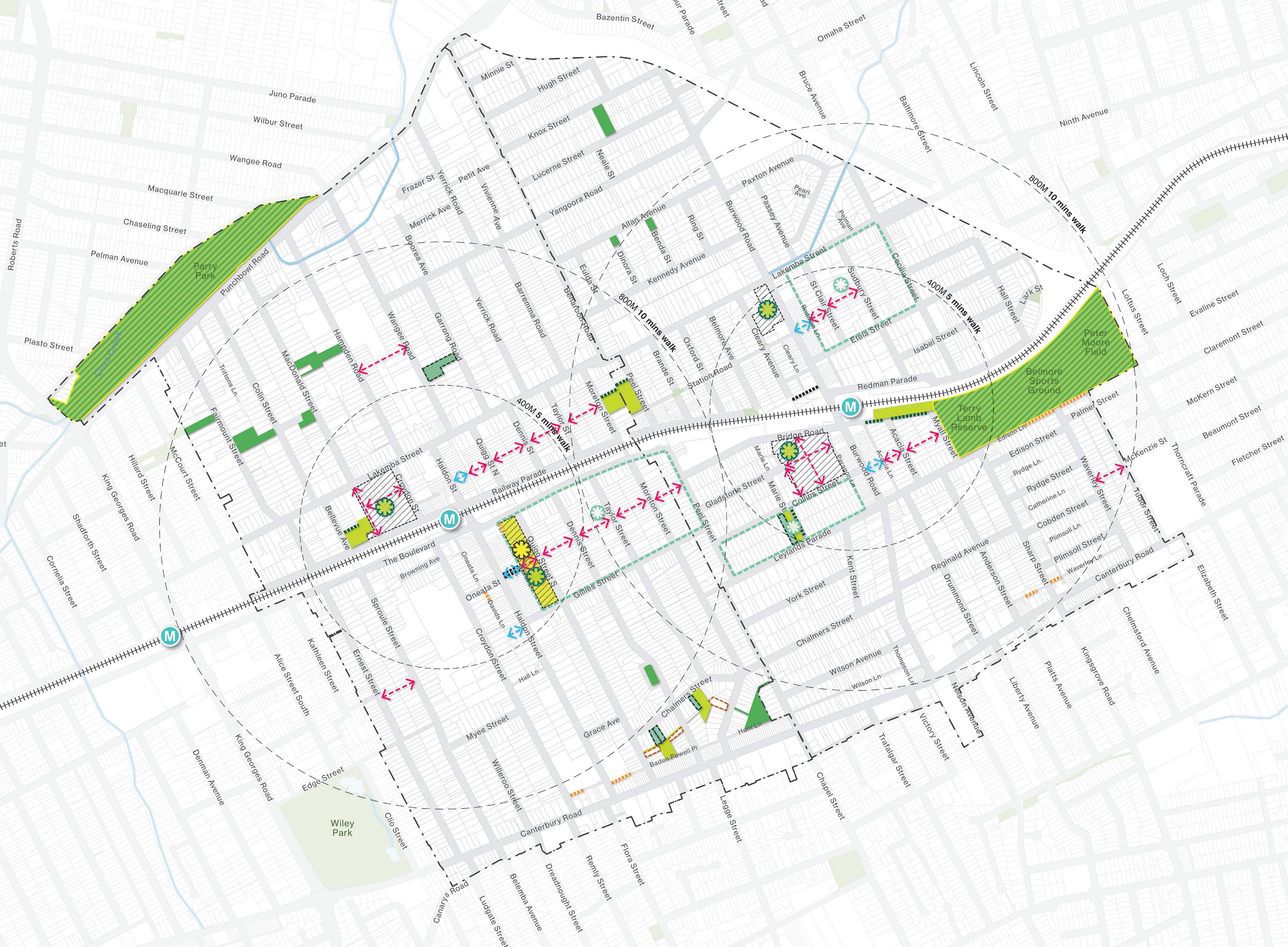
The following principles describe key ideas to enhance the access, connectivity, function and activation of the Belmore Sports and Recreation Precinct.
Existing through site connections - consider opportunities for enhancement
Existing pedestrian and cycle underpass - consider opportunities for enhancement
Aspirational future connections subject to existing and future lease arrangements
Potential future through site link delivered through urban renewal will support connection between the precinct and Burwood Road
Future gateway and arrival points to provide wayfinding and precinct information
Enhanced connection and arrival
Non-replacement of the existing bowling club for expansion of open space and new level 1 destination playground
Active recreation and stormwater basin function
Proposed NRL Bulldogs Centre of Excellence
Existing grandstand
1 Potential future stadium arrival and entranceflexibility for events, markets
2 Elite Sports Use - Restricted Public Access (current use by NRL Bulldogs and Sydney Olympic Football Club)
3 Community facility within grandstand
P Limited parking areas to service day-to-day operation of stadium
Future residential development to consider interface with park e.g. housing fronting park, landscape treatments, setbacks and building orientation
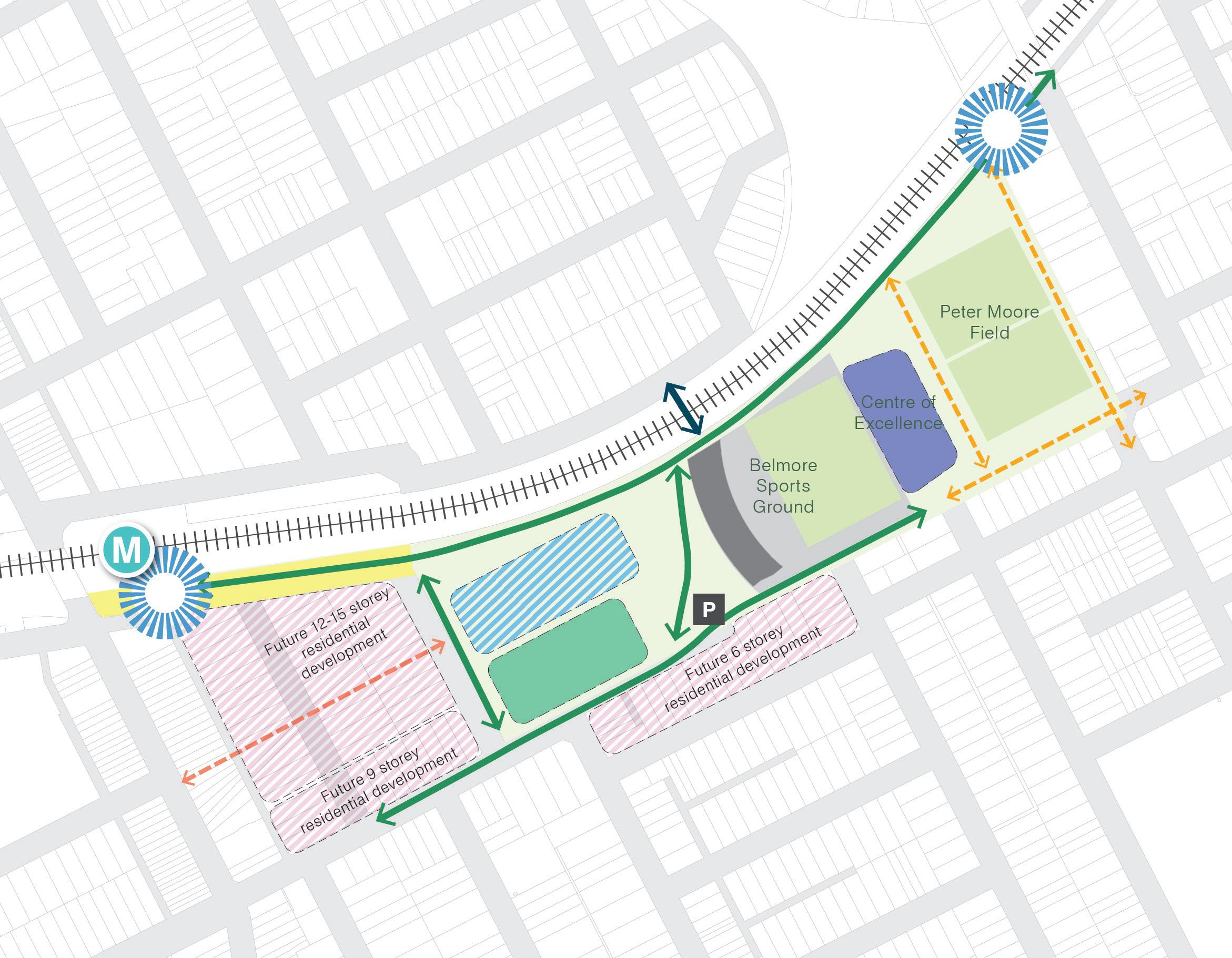
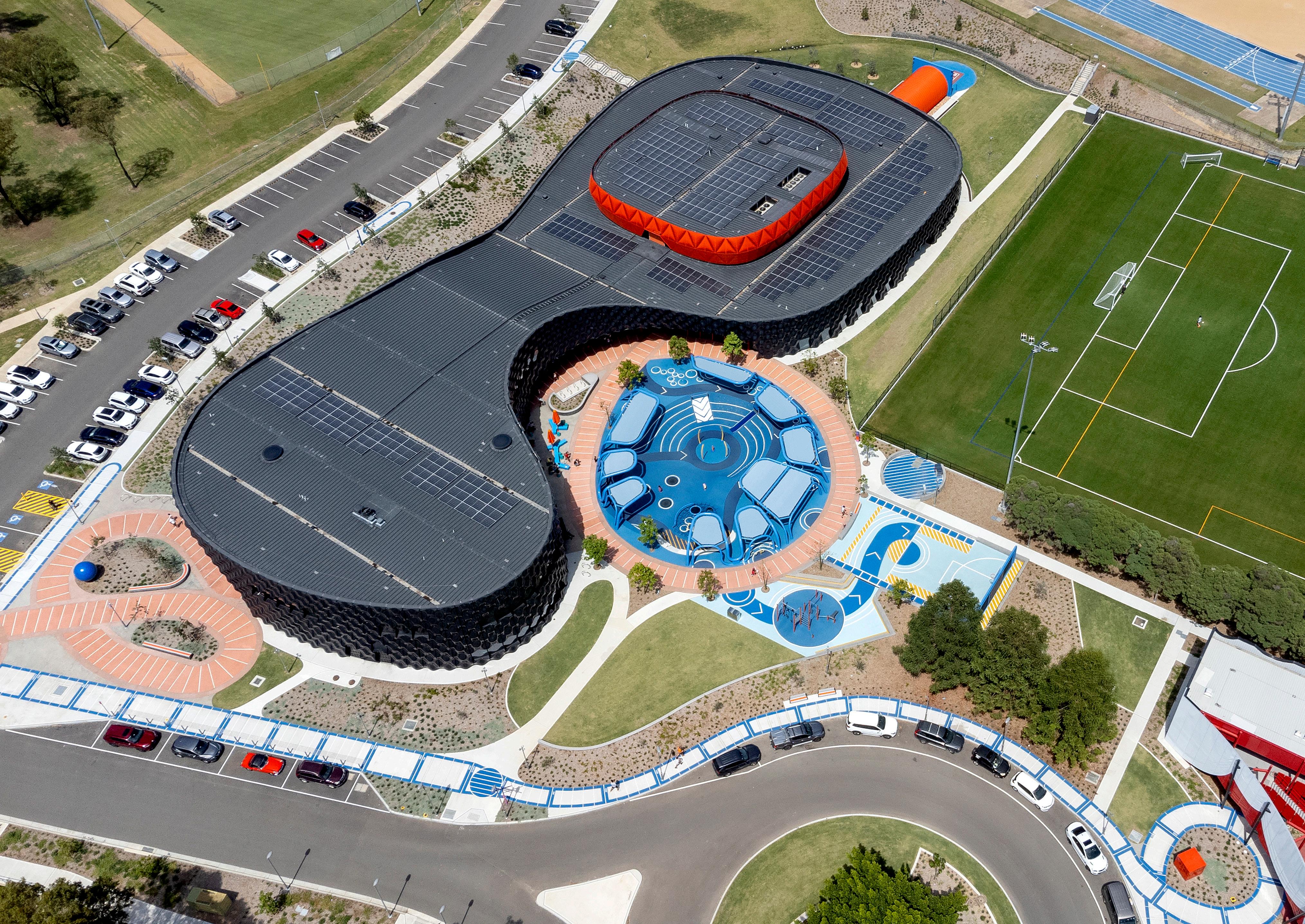
Principles
Consolidation of community facilities including library, senior citizens centre and other multipurpose facilities
· Co-location of open space (approx. 3,000sqm) and community facilities
· Expanded and activated pedestrian link to Haldon Street
· Pedestrian and active transport connections to Lakemba Station and surrounding residential areas
Consolidation of car parking in multi-deck or underground car parking facilities
Potential for mixed-use development in this precinct, such as ground-level commercial and retail uses, high-density residential development and/or affordable housing
· Range of height and FSR to facilitate these across block to create a varied built form and facilitate key public benefits: range from 6 to 18 storeys and 3:1-4:1 FSR.
New community facilities including library, senior citizens centre and multipurpose facilities
Co-location of open space (approx. 3,000sqm) and community facilities
Potential mix of uses such as community facilities, retail, highdensity residential development and/or affordable housing
Range of heights and FSRs across precinct to create a varied built form
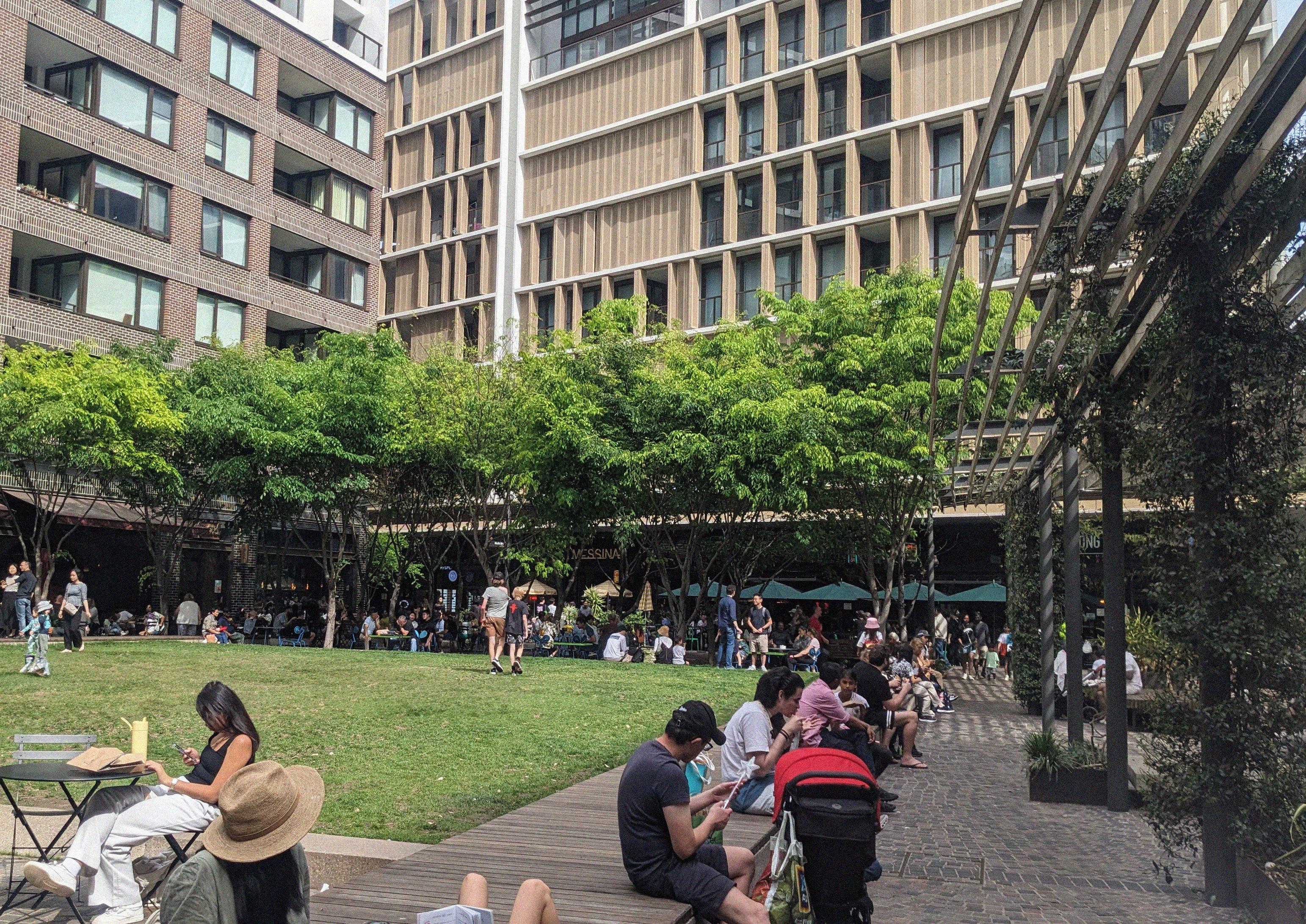
Creation of a new community precinct in the heart of Lakemba with open space, community facilities, active connections with Haldon Street, consolidated car parking and a mix of retail, residential and community uses.
A number of new heritage listings have been proposed as part of this master planning process. The proposed heritage items and conservation areas are based on an independent heritage study by Extent Heritage. The full list is provided in the Recommended Planning Provisions report.
Heritage items often have great historical, social and architectural significance that contributes to supporting the local character of the area, and should be retained and celebrated.
Future development interfaces to heritage items and conservation areas should also consider adequate building separation, landscape and tree canopy and built form transitions.
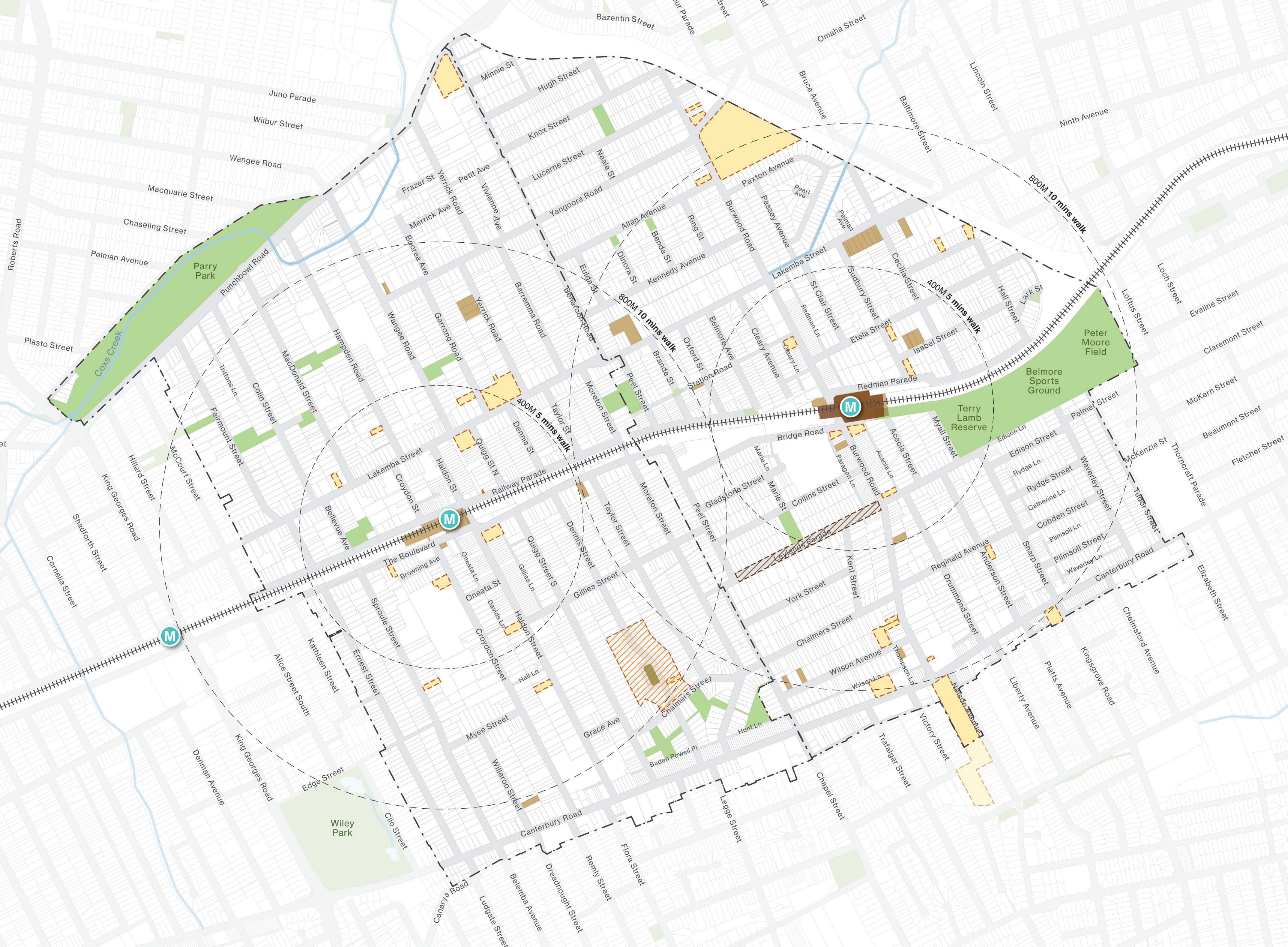
1 The greatest heights are focused close to the station where it is most accessible. This includes predominantly up to 9 storeys, and up to 12-15 storeys on blocks adjoining the main street, identified as having increased housing potential.
2 Key sites may be able to achieve additional height with the provision of community infrastructure, with a mix of building heights varying by site, up to 12-18 storeys.
3 The main streets are predominantly 6 storeys, with some 8 storey development at the northern end of Haldon Street, and up to 12 storeys adjacent to the future open space and community precinct in Lakemba. This retains the built form scale and character of the main streets while allowing for development potential. Height is located behind the main street, where visual impacts may be less.
4 Other existing high density residential areas allow for infill development of 4-6 storeys. These areas currently consist of 2-4 storey walk-up apartments. Moderate uplift within these areas would allow for some development potential while complimenting the existing character of the area.
5 Other areas remain low scale with 1-2 storey development, corresponding to low-rise medium density development.
6 Development opportunities adjacent to Canterbury Hospital and the Belmore Sports and Recreation Precinct of 6-8 storeys.
7 Reinforce existing heights along Canterbury Road, ranging between 4-8 storeys.
8 Areas that may include sharper built form interfaces or sensitive interfaces should consider increased street setbacks (minimum 6m) and building separation.

1 An FSR of 2.5:1 generally aligns with a maximum 9 storey residential development, located predominantly along the train line and within a 5 minute walk of the future Metro station.
2 An FSR of 3:1 general aligns wi1h a maximum 12 storey residential development, for blocks in very close proximity to the future Metro station and main streets.
3 The FSR on key sites vary, ranging between 2.5:1 to 4:1. The general principle is that additional height and FSR may be permitted on key sites to enable greater area at ground for new open space and through site links.
4 A 3:1 FSR along the main streets, which can enable efficient mixed use 6-8 storey mixed use development with retail uses at the ground floor.
5 An FSR of 1.2:1-1.7:1 can generally enable 4-6 storey residential development.
6 An FSR of 0.7:1 allows for medium density development in the form terraces, townhouses and multi-dwelling housing in the R3 medium density residential zone.
7 The FSRs along Canterbury Road enable a mix of mixed use, residential and employment uses ranging between 1.2:1 to 3:1.

Building typologies
The following pages describes and guides the desired future built form character and key considerations for each building typology across the Belmore and Lakemba Local Centres.
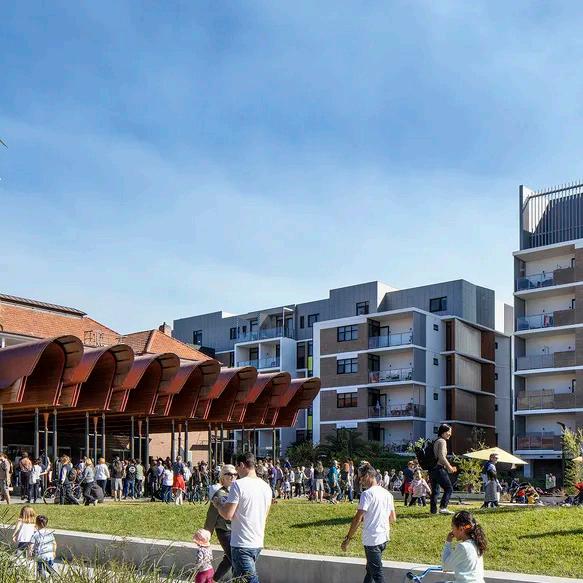
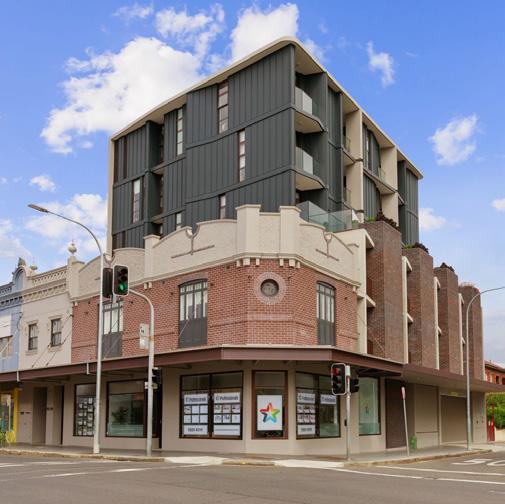


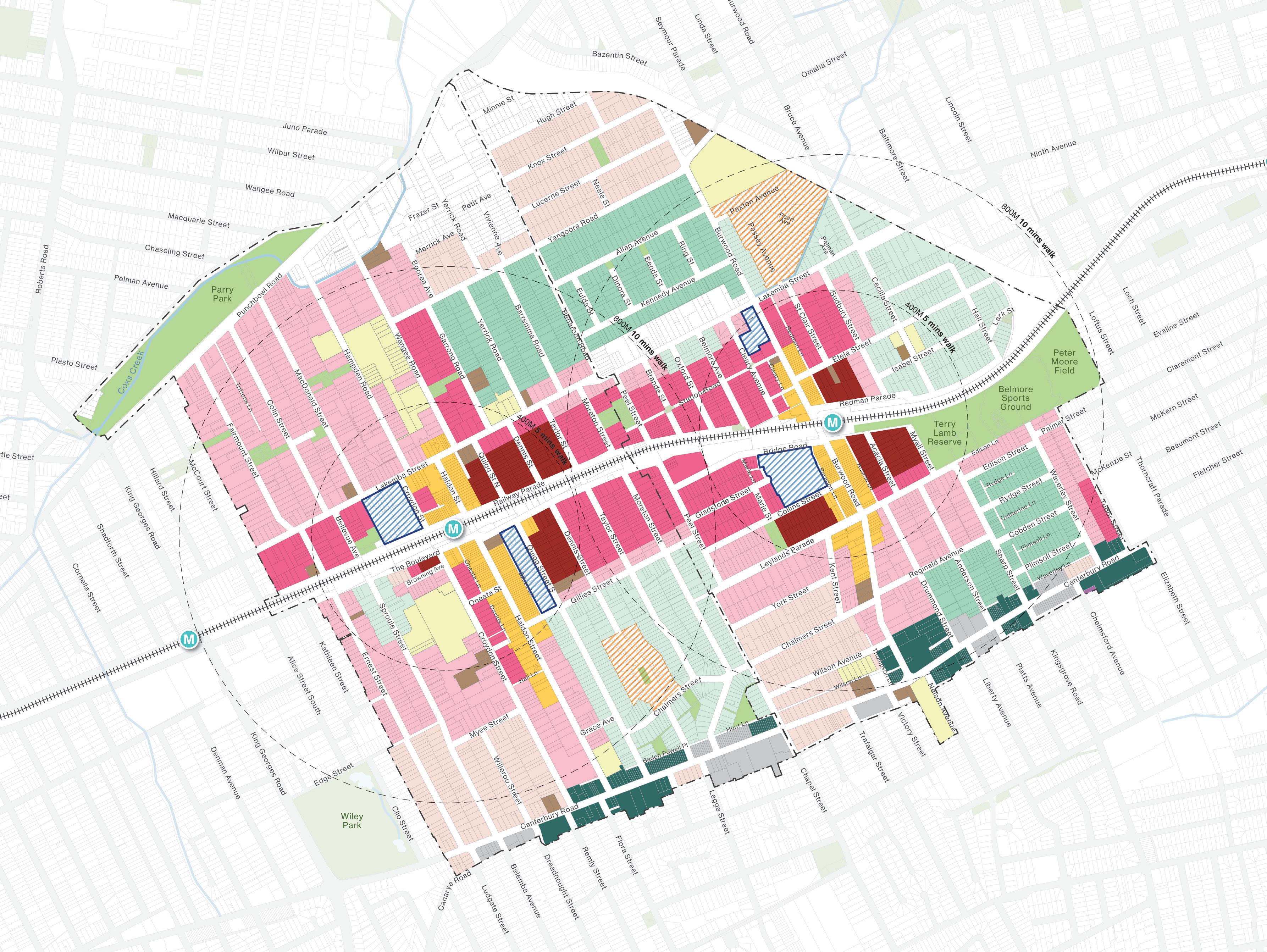
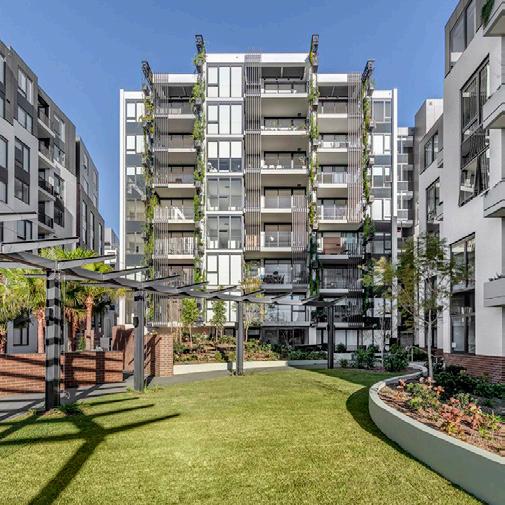
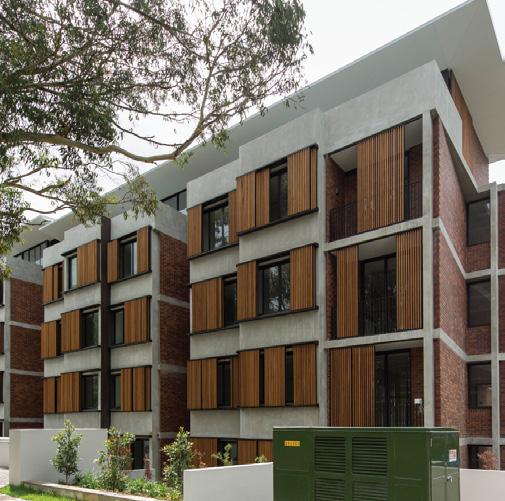
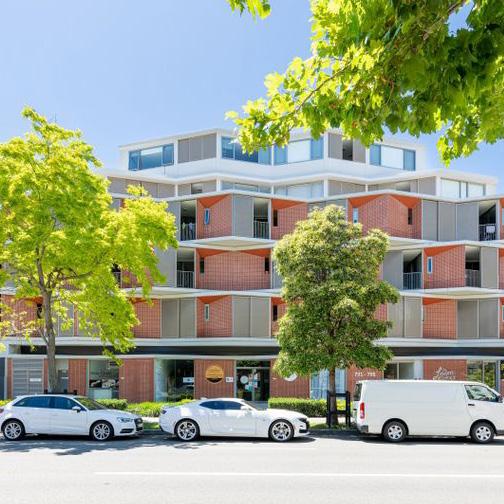
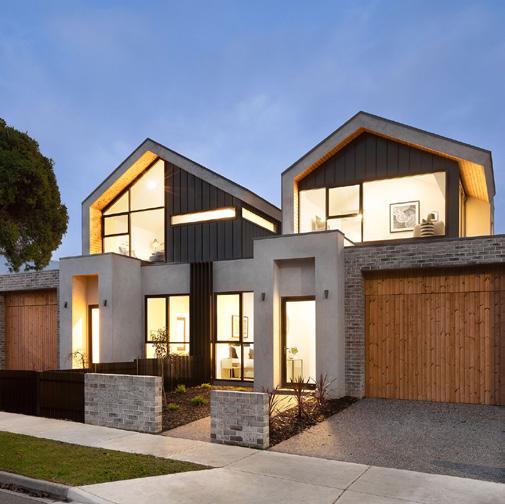
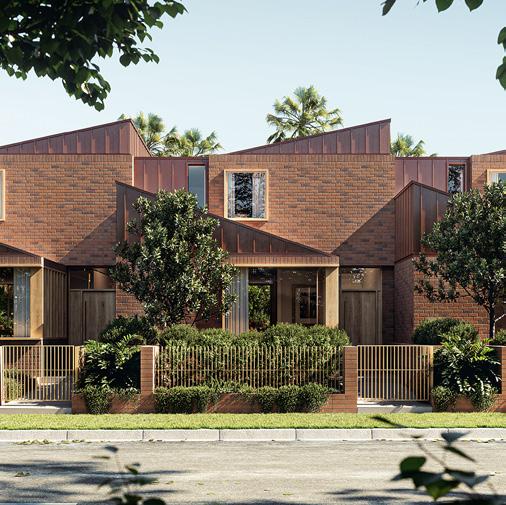
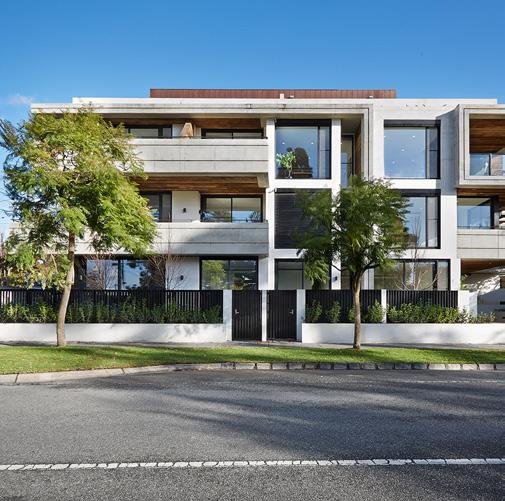
Key sites are sites or precincts that have high renewal potential with the opportunity to provide increased housing along with supporting community infrastructure, including a new public open space, pedestrian through site links and community facilities.
These sites have been identified due to their strategic location in close proximity to the station and main streets, significant size (over 5,000sqm), and predominantly consolidated land ownership pattern. The key sites include:
Canterbury Leagues Club
· 'Jubilee block' - the block bounded by Lakemba Street, Croydon Street and Railway Parade.
· 'Quigg Street block' - the block behind Haldon Street predominantly consisting of Council car parks.
· 'Burwood Rd north' site - an existing large StateGovernment owned site.
Larger sites have the potential to deliver precinctstyle development that can support a variety of uses, provide activation opportunities and include community infrastructure. The key sites will have additional building height to allow for taller buildings. This will provide a level of design flexibility in these sites and incentivise the delivery of community infrastructure. It will also allow these sites to become urban landmarks, helping to draw people into the centre.
These sites will be further developed in the Development Control Plan, to provide clear and well-considered design principles that help guide high quality built form and public outcomes on the nominated key sites.
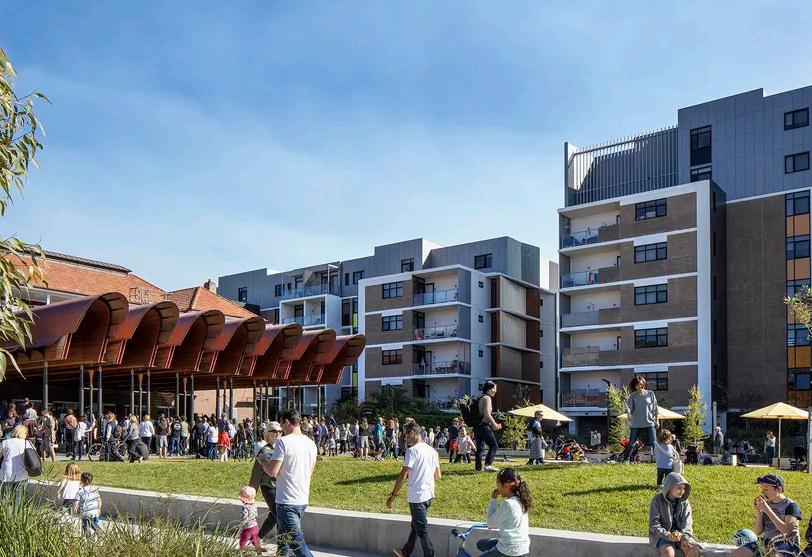
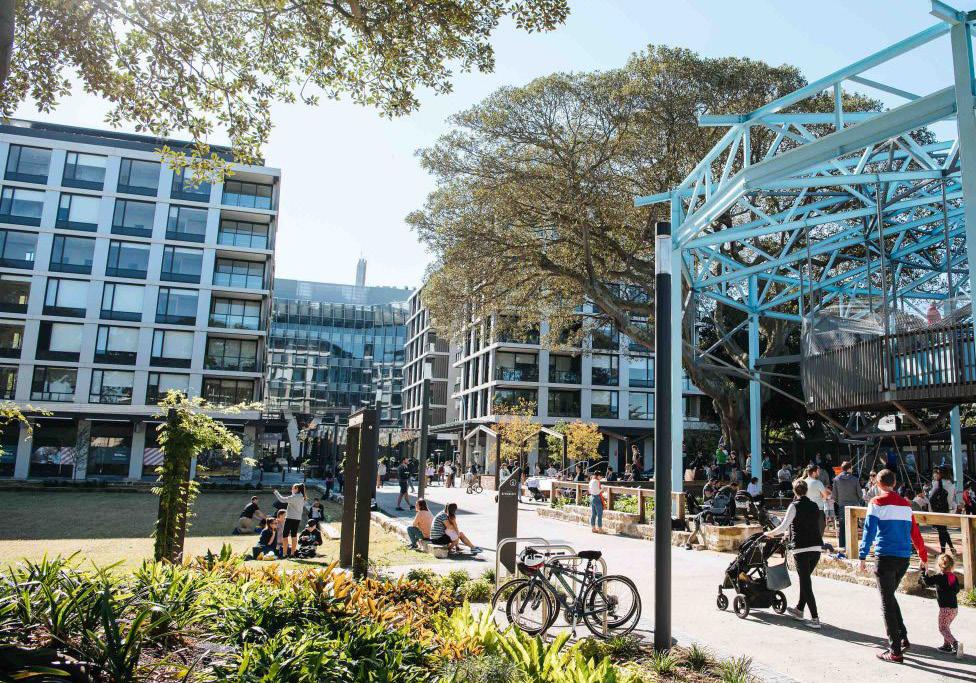

Haldon Street in Lakemba and Burwood Road in Belmore are the lively main streets and community heart of the centres. The main streets provide everyday retail, services and amenities and are areas of high pedestrian activity, while also supporting community life and events. The fine grain, historic shopfronts and consistent street wall create a comfortable pedestrian scale and add to the vibrancy of the street.
The future built form approach for the main street retains the fine grain character and predominant 2-3 storey street wall. Any levels above are set back behind the street wall to minimise the visual impact from additional height.
The maximum building of 6 storeys and 3:1 FSR enables some development opportunity while maintaining the character of the main street. Key corners or other key strategic locations along the B2-zoned main street may including buildings up to 8 storeys in height, marking key corners or attractors.
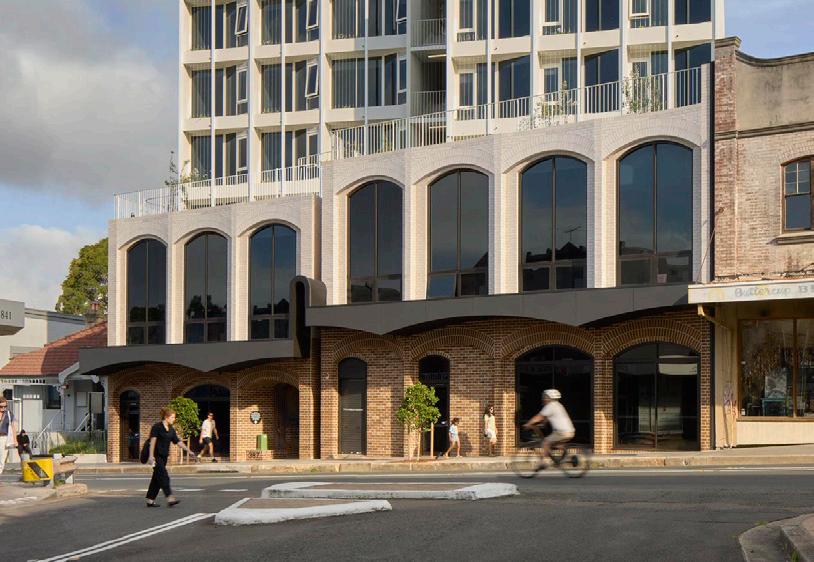
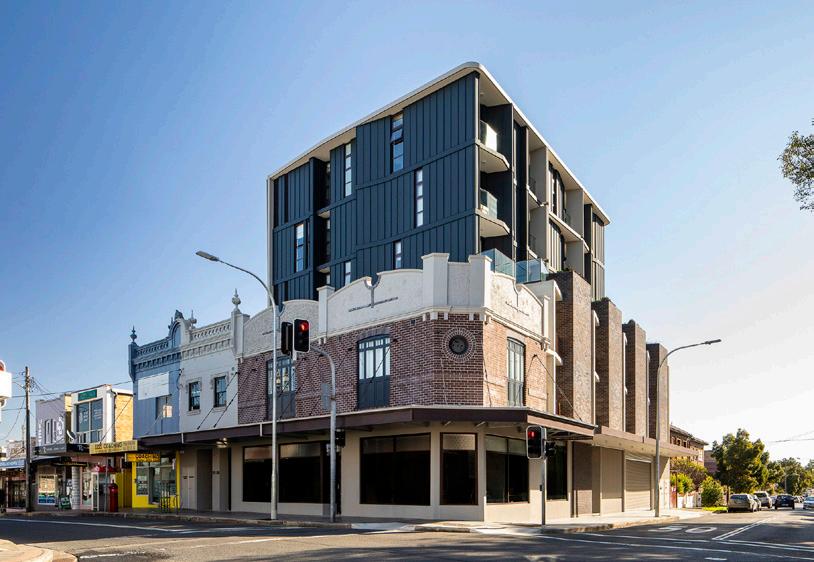
5 3m setback above street
6 Maximum 5 storeys along main street
7 Maximum 6 storeys along laneway/rear
8 Above podium/rooftop communal open space
9 Basement and service access from laneway/rear - 3m setback for deep soil and/or servicing needs
CHigh density residential 12-15 storeys | FSR 3:1-3.6:1
These high density residential areas refer to key blocks that have been identified as having an opportunity for increased housing provision given their strategic location close to the future Metro and main streets. These areas are also predominantly unconstrained by strata title or environmental issues.
Heights of up to 12-15 storeys are proposed within this area. A 4-storey street wall height provides a scale transition to existing and future surrounding development, while a slender and well-separated tower form above minimises visual and amenity impacts.
This approach enables greater height and density that aligns with the aims of the TOD Program, with additional minimum lot size (1,500sqm), frontage (36m) and setback requirements to ensure high quality design outcomes for the streetscape, protect residential amenity and improve landscaping and communal open space at ground level.


DHigh density residential 9 storeys | FSR 2.5:1
High density residential development is focused along the railway line and within walking distance of the station.
This residential typology is based on a 'garden-style' apartment with landscaped front, side and rear setbacks, that maximises deep soil and planting opportunities.
A 4-storey street wall height provides an appropriate transition to existing lower scale development as the area transforms over time. The street wall height combined with landscaped front setbacks, creates a comfortable pedestrian-scale to the street, with additional height set back further from the street.
The maximum building height is 9 storeys with an FSR of 2.5:1, enabling a greater density that aligns with the aims of the TOD Program, with additional lot size (1,500sqm), frontage (36m) and setback requirements to ensure high quality design outcomes, protect residential amenity and improve landscaping and deep soil opportunities.
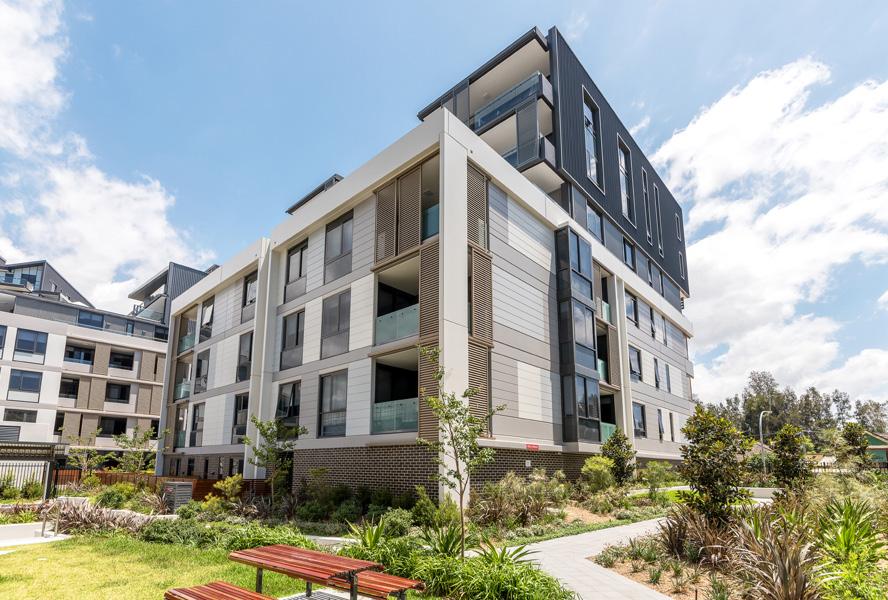

1
2
3 Minimum 6m side for deep soil and landscaping
4 Minimum 9m rear setbacks or deep soil and landscaping 5 4-storey street wall
6 Additional 3m setback for upper levels
7 Communal open space at ground and rooftops
8
Mid-rise medium density areas include existing R4zoned land beyond the core intensification areas around the station, that consist of a predominant residential flat building typology or are suitable for more moderate increases in density due to their proximity to Metro, shops, open spaces or other community attractors. Given the large amount of strata title within some of these areas, new development may occur incrementally on unconstrained sites.
The resulting infill development consists of a mid-rise 6 storey form with a 4 storey street wall, that responds to the existing 3-4 walk-up apartments and low scale housing.
Generous setbacks on all sides as well as minimum 30m frontage and 1,500sqm lot size controls maximise opportunities for deep soil and communal open space, while also addressing privacy and solar amenity outcomes. New development within these areas, will also contribute to enhancing the streetscape character.
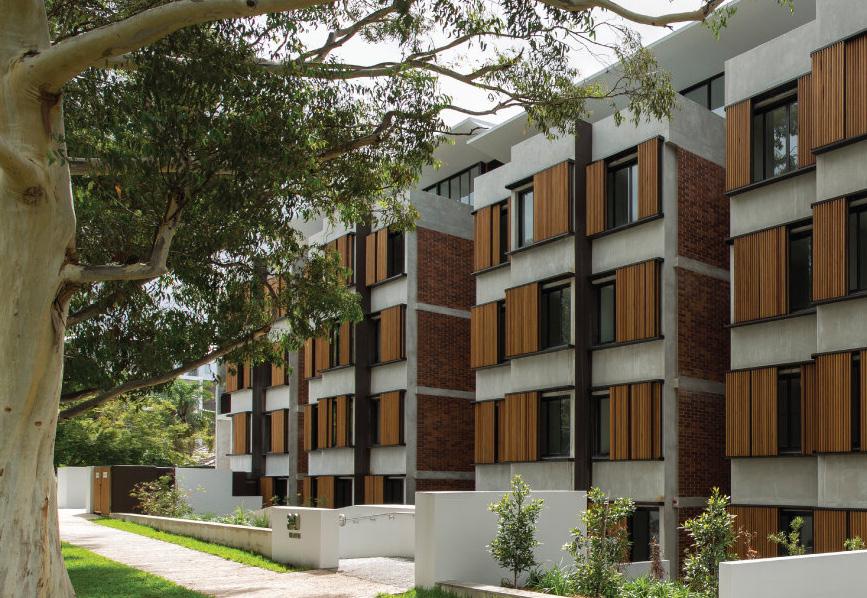
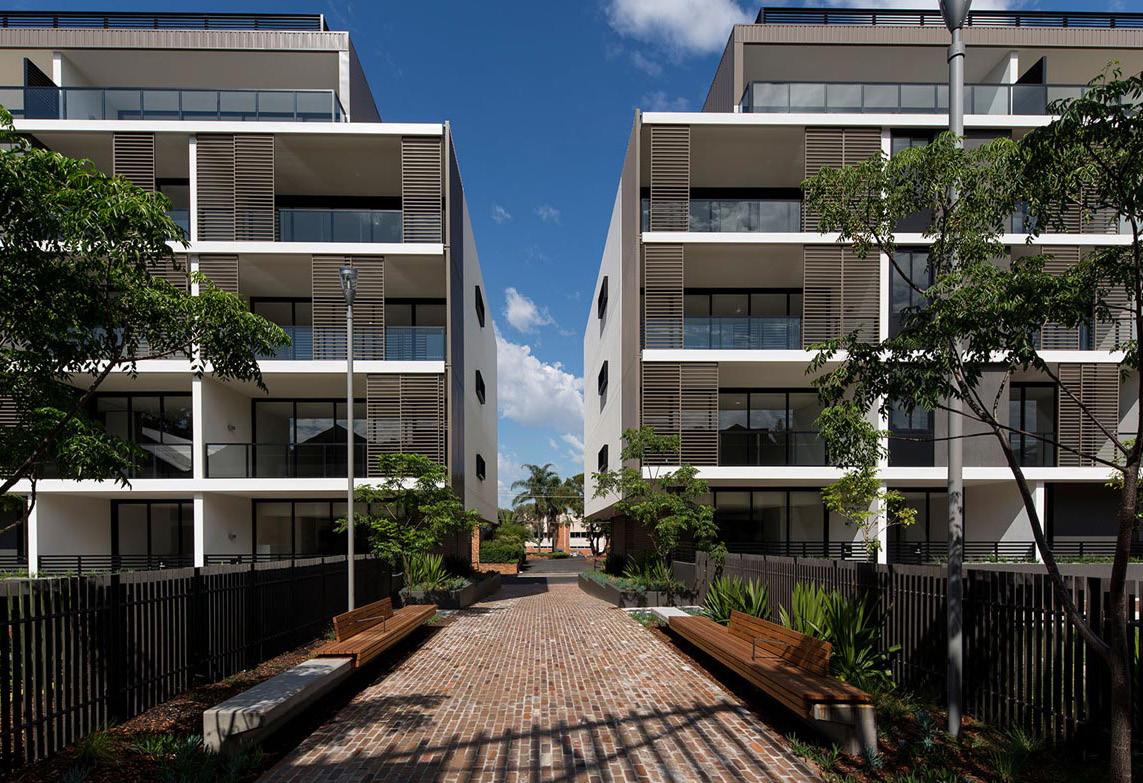
These mid-rise medium density areas include existing R4 or proposed re-zoned R3 land that are located further from the station but have been recognised as having moderate renewal potential. These areas currently consist of a mix of residential types including small apartments, medium density housing and single dwellings.
Moderate development in the form of a 4-storey residential flat building with 3-storey street wall integrates well within its existing context.
A minimum lot size control of 1,200sqm encourages smaller lot consolidation to occur for new development, while a minimum 30 lot frontage can provide opportunities for generous landscape setbacks and deep soil, minimise driveway crossovers and enhance the streetscape character.


1 Minimum 30m lot frontage and 1,200 sqm lot size (approx 2-3 lot amalgamation)
2 3m front setback - trees, landscaping and garden apartments
3 Minimum 6m side and 9m rear setbacks with opportunity for deep soil and landscaping
4 3-storey street wall/podium
5 Additional 3m setback for upper level
6 Maximum 4 storeys
open space at ground and rooftops
7 Communal open space at ground and rooftops
Low-rise medium density housing 1-2 storeys | FSR 0.7:1
The areas located between Yangoora Avenue and Lakemba Street, and Waverley and Sharpe Street are great locations for moderate renewal in the form of medium density housing, such as dual occupancies, terraces/townhouses and multi-dwelling housing.
These areas are predominantly located within a 5-10 minute walk of the station and main street, as well as being within walking distance of key attractors such as the Belmore Sports and Recreation Precinct, Canterbury Hospital and local schools.
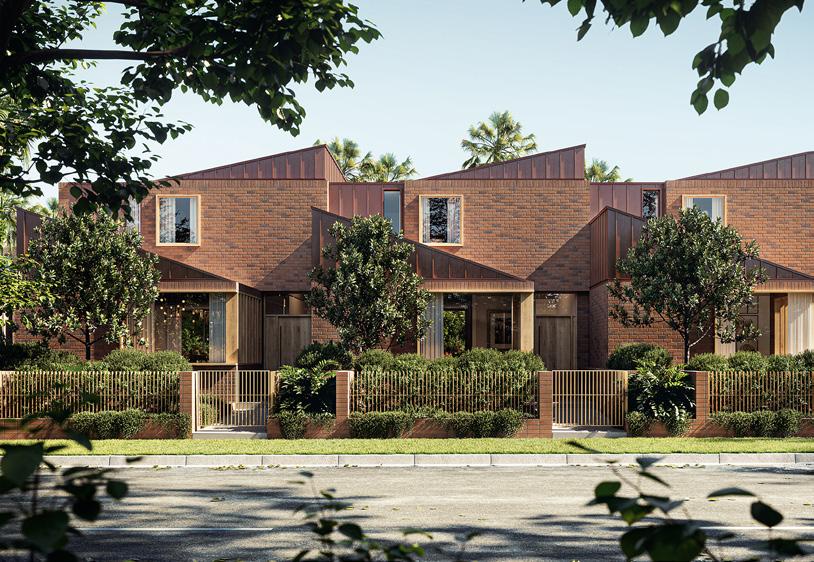
The terrace typology shown below and in the images adjacent provide moderate renewal that retains the existing streetscape and built form character. Minimum lot size (1,000sqm) and frontage (20m) controls encourage this 'missing middle' typology while ensuring good streetscape outcomes such as landscaped setbacks and tree canopy, and fewer driveway crossovers. H Low to medium density housing 1-2 storeys | FSR 0.5:1

1 20m minimum lot frontage and 1,000sqm site area (approx 2-lot amalgamation)
housing 1-2 storeys | FSR 0.5:1
The low density and low to medium density housing areas are places that have been identified as having great neighbourhood character to be retained and celebrated. The medium density areas will continue to provide small scale redevelopment in the form of single dwellings, dual occupancies and manor houses.
Interfaces with the proposed Dennis Street heritage conservation area will need to be considered including adequate separation and built form transition.
Two areas have been nominated to be rezoned from R3 Medium density residential to R2 Low density residential along Dennis Street, and Passey/Paxton Avenue, which aims to preserve the existing local character.
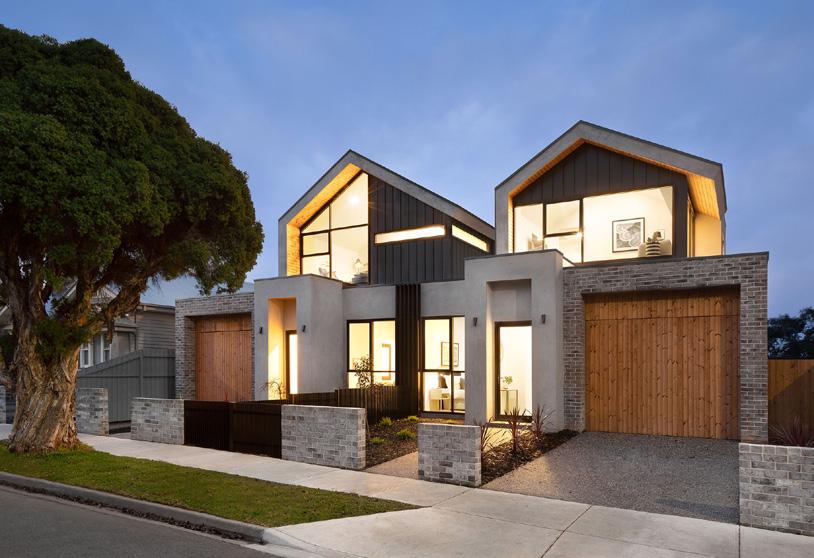

1 6m front setback to compliment existing character and provide opportunity for trees, and landscaping within front gardens
2 Maximise trees within backyard
3 Maximum 2 storeys
4 Minimise drive crossovers to provide opportunity for street trees and landscaping
Canterbury Road mixed use 6-8 storeys | FSR 2:1-3:1
Mixed use development will be concentrated at key nodes within the Canterbury Road corridor including at the intersection with Haldon Street, Burwood Road and around the Canterbury Hospital.
Future development will build on the existing mixed use character along Canterbury Road and support infill development opportunities of up to 6-8 storeys.
A minimum 5m ground floor can support large format commercial uses including showroom retail, bulky goods, medical and allied health and wellbeing, as well as everyday services and amenities for the local community.
Residential are located above the ground floor, well separated and oriented away from the busy road towards greater amenity as much as possible. The streetscape will be enhanced through widened footpaths, verges and street trees.

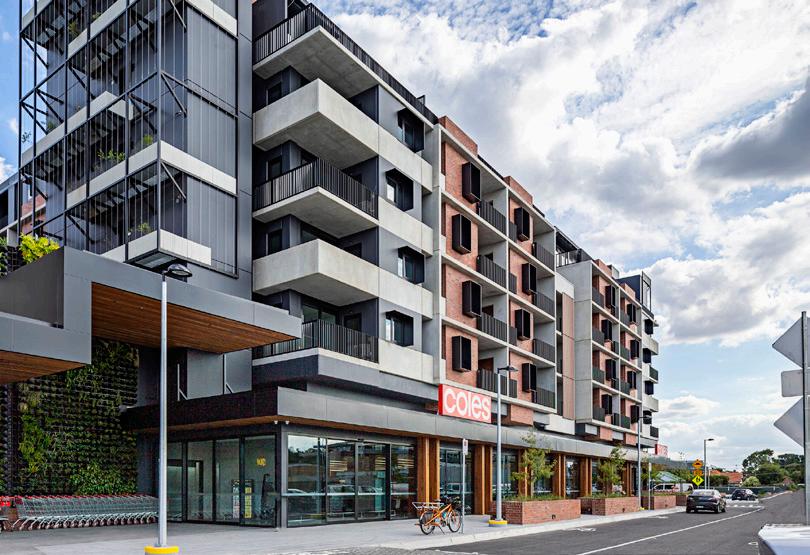
Canterbury Road employment use 5 storeys | FSR 1.8:1
Canterbury Road will continue to be an important vehicle connection as well as provide employment opportunities for the local area.
New development may provide a range of employment uses including retail, mixed business, commercial, bulky goods, medical and allied health uses.
Employment uses will be located in pockets between mixed use and residential development, consisting of buildings up to 5 storeys. The proposed maximum building height control accommodates larger floor to floor heights that can support a variety of large format employment uses, which are difficult to provide in urbanised areas.
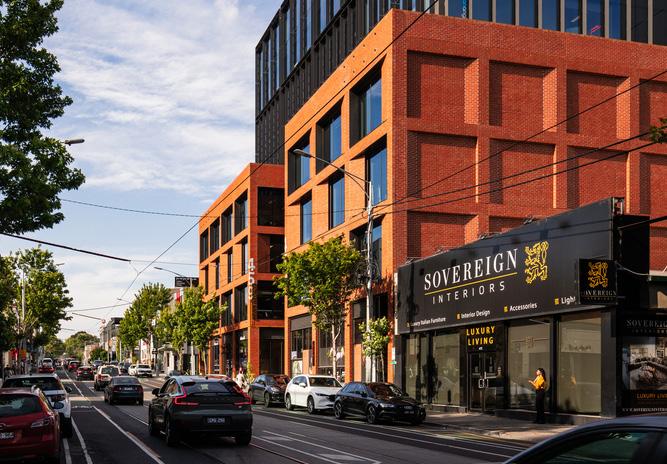
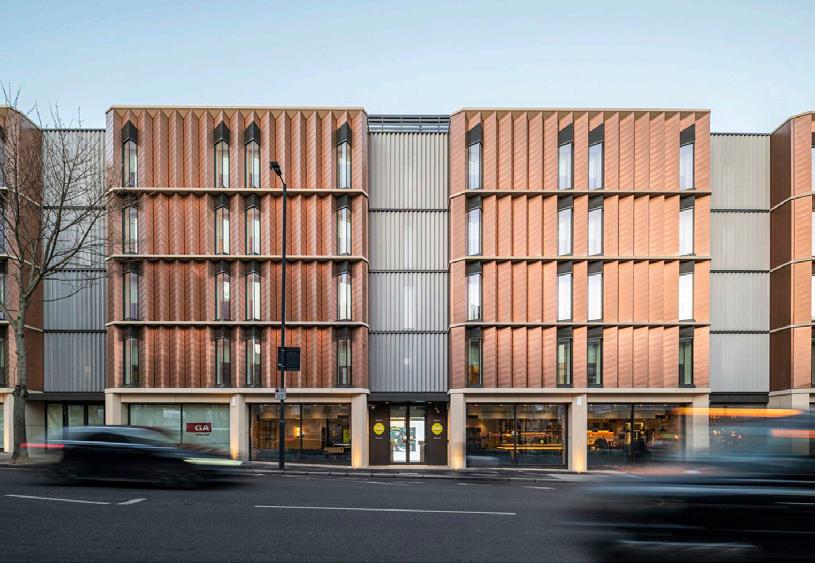
1
2
3

This report describes a draft approach to planning for the future growth of the Belmore and Lakemba Local Centres. It presents an alternative approach to the controls under the TOD SEPP, based on a well-considered, iterative and collaborative design process, that understands the unique role and character of Belmore and Lakemba.
The alternative approach looks at both centres holistically, and is able to deliver more and diverse housing than identified under the TOD program.
The proposed approach is place-specific, responds to built form and environmental constraints, and delivers community infrastructure to support new housing.
The implementation of the proposed built form and community infrastructure approach described within this report is outlined in the Recommended Planning Provisions report.
The proposed planning provisions identifies draft built form controls including land use zoning, height of building, floor space ratio, and minimum lot size and frontage, as well as proposed additions to heritage listings, proposed land reservation acquisition and additional clauses related to affordable housing, key sites and additional permitted uses.
Both the Alternative Approach to TOD report and Recommended Planning Provisions report have been placed on an initial public exhibition to gain feedback from the community and key stakeholders.
The alternative approach will be further developed following community engagement, to refine key elements including the built form, public domain and community infrastructure.
Council will also prepare amendments to its Development Control Plan and Local Infrastructure Contributions Plan and will undertake more detailed public domain planning in these centres. Further engagement and consultation with the community will be an important part of this process.
October 2022
April 2024
Place analysis study and visioning for the Belmore Lakemba Local Centres City of Canterbury Bankstown Council (with Architectus and consultant team)
Belmore and Lakemba announced as Tier 2 precincts as part of the Transport Oriented Development (TOD) program (NSW Government)
Mid 2024
October 2024
November 2024
Development of the draft Alternative Approach and proposed planning controls City of Canterbury Bankstown Council (with Architectus and consultant team)
We are here
Public exhibition of the 'An Alternative Approach to TOD' report and 'Recommended Planning Provisions' report
Revised draft Alternative Approach to TOD and Recommended Planning Provisions reported to Council City of Canterbury Bankstown Council (with Architectus and consultant team)
December 2024
Early 2025
Early-mid 2025
Mid 2025
TOD finalisation for Belmore and Lakemba (NSW Government)
Preparation of amendments to Council's Development Control Plan and Local Infrastructure Contributions and more detailed public domain planning
City of Canterbury Bankstown Council (with Architectus and consultant team)
Public exhibition of draft DCP, Contributions Plan amendments and public domain planning
Finalisation of draft DCP, Contributions Plan amendments and public domain planning
City of Canterbury Bankstown Council (with Architectus and consultant team)